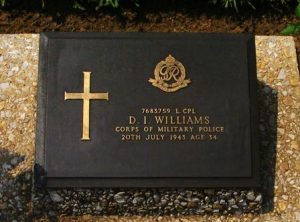Rhayader is a market town situated on the junction of the A470 road and the A44 road, some 13 miles north of Builth Wells and 30 miles east of Aberystwyth, about 20 miles from the source of the River Wye on Plynlimon. The men of the parishes of Rhayader, Abbeycwmhir, Cwmdauddwr, Llanwrthwl, Nantmel and St Harmon, who fell during both World Wars are commemorated on a fine war memorial located in East Street, which takes the form of a clock tower. There are 88 names listed for WW1 and 20 for WW2. The memorial was unveiled by Lord Ormathwaite on 18 September 1924. The clock was donated by Mrs Mary Ann Lewis, in memory of her late husband Evan. At least one man from Rhayader fell during the earlier Boer War. He is not commemorated on the war memorial, although his brother, who fell during WW1, is, so I have added him below.
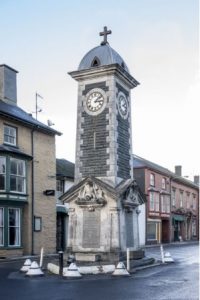
————————————————————————————————————————————————
The Boer War, 1899-1902
Harry Seddon Prickard, Captain, North Staffordshire Regiment. Harry was the eldest son of Reverend William Edward Prickard and Maria Georgiana Prickard (nee Morris), of Dderw, Rhayader. He was educated at Winchester College before being commissioned into the 2nd Battalion, North Staffordshire Regiment in February 1888. Harry served in Zululand after gaining his commission, and by the time his battalion moved into positions to participate in the Boer War in January 1900, he had been promoted to Captain. He had taken part in the Battle of Paardeberg and the advance on Bloemfontein, but took ill there and died of enteric fever on 12 May 1900. His youngest brother, Gerald Thornton Prickard, was killed at Gallipoli in 1915.
————————————————————————————————————————————————
The Great War, 1914-1918
William Osborne Abel, Private, 429513, Canadian Infantry. William was born on 2 December 1891, the son of John Evans Abel and Mary Abel, of Hendre Awr, Llanidloes. He worked as a waggoner at Cefn Llech Farm, Rhayader prior to emigrating to Canada. William had joined the 104th Militia prior to enlisting into the 47th Battalion, Canadian Infantry at New Westminster, British Columbia on 13 March 1915. He embarked for England with the battalion on 1 October 1915, and joined the Canadian depot at Salisbury Plain. On 29 February 1916 William was posted to France, joining the 16th Battalion, Canadian Infantry, which was at Ypres attached to the 3rd Brigade, 1st Canadian Division. He was shot on 12 May, when the Germans launched a fierce artillery and machine-gun barrage onto his battalion’s positions at Scottish Lines, and was evacuated to the 3rd Canadian General Hospital at Boulogne for treatment. William was not posted back to the battalion until 29 June 1916, so missed the two weeks of desperate fighting the Canadians suffered during the Battle of Mount Sorrel, and re-joined the battalion at Railway Dugouts. The Canadians remained in the Hill 60 sector over the coming weeks, with its infantry battalions carrying out the usual system of trench rotation, then in August the Canadian Corps moved south to the Somme sector, relieving the Australians in front of Mouquet Farm. The Canadians then saw heavy fighting over the coming weeks, during the Battle of Flers – Courcelette from 15 September. William was posted as missing, believed killed in action near Courcelette on 28 September 1916. No trace of the 24-year-old was ever found, and he is commemorated on the Vimy Memorial, France. His brother, John Pugh Abel, died whilst training at Oswestry in 1917. Both brothers are commemorated on the Llanidloes and the Llangurig war memorials.
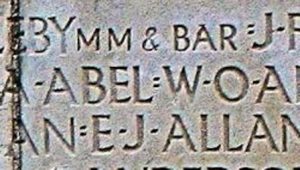
Thomas Arthur, Sergeant, 14599, South Wales Borderers. Thomas was the son of John and Mary Arthur, of Rhayader. He was a long serving soldier, after having enlisted into the South Wales Borderers at Brynmawr on 13 February 1895. After leaving the army he first moved to Crumlin to work as a coal miner, before marrying, and lived with his wife, Minnie Arthur, at Silverton, 7, Pentonville, Newport, Mon. Following the outbreak of war, Thomas re-joined his old regiment, and was posted to the 8th Battalion, South Wales Borderers. The battalion formed at Brecon, moving to Seaford to join 67 Brigade, 22nd Division, and on 6 September 1915 the entire Division landed at Boulogne, concentrating near Flesselles by 9 September. It’s stay in France was very short, as on 27 October 1915 the Division, having been moved by train to Marseilles, began to embark for Salonika. It completed concentration there in November, and moved to the Serbian frontier, following the invasion of Serbia by the Austrian and Bulgarian forces. The Division remained in the Salonika theatre for the rest of the war, taking part in the Retreat from Serbia during December 1915. During August 1916 the Division fought at the battle of Horseshoe Hill, then during September 1916 at the battle of Machukovo. The Division then took part in two major battles around Lake Doiran in 1917, and it was during the second such battle, on 9 May 1917, that Thomas was killed in action. The 38-year-old is buried in Karasouli Military Cemetery, Greece.
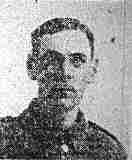
Harry Lloyd Bacon, Lieutenant, Royal Navy. Harry was born at Birmingham at Coleshill, Warwickshire on 18 April 1883, the son of James Alexander and Elizabeth Ann Bacon. The family had taken over the Warwick Temperance Hotel at Rhayader by 1901. Harry enlisted into the Royal Navy as a Boy Sailor on 18 April 1901, and his first posting was aboard HMS Impregnable. Harry had several postings over the coming years, including ships such as HMS Minotaur, HMS Irresistible, HMS Renown and HMS Defiance prior to the war. Harry married Emily Jones, of Church Street, Rhayader, whilst on leave in 1909. On 15 April 1911 Harry passed as a gunner, and was posted aboard HMS Colossus before being posted to HMS Vivid and undergoing training prior to becoming Acting Mate on 1 August 1915, then promoted to Lieutenant on 1 August 1917. By now Harry was serving aboard the heavily armed monitor HMS Raglan, which was based at Imbros, in the Eastern Mediterranean. On 29 October, Raglan took part in the Third Battle of Gaza, using her 14-inch guns to pound the Turkish defences. On 20 January 1918, Raglan and other members of the Aegean Squadron were attacked by the Turkish battlecruiser Yavuz Sultan Selim (formerly the German battlecruiser SMS Goeben), the light cruiser Midilli (formerly the German light cruiser SMS Breslau) and four destroyers. Hopelessly outclassed, HMS Raglan was sunk with the loss of 127 lives. Harry was 34 years old when he was killed during the sinking of Raglan. His body was recovered by a RN diver after the sinking, and he was buried at Panaghia, on the Greek island of Thasos. After the war his remains were exhumed, and re-buried in Lancashire Landing Cemetery, Gallipoli.
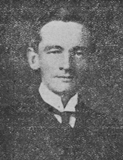
Thomas William Bird, Private, 38306, Cheshire Regiment. Thomas was the son of Andrew and Emma Bird, of Adforton, Leintwardine. He was a farmhand at Nantmel prior to enlisting at Knighton into the 19th Battalion, Welsh Regiment on 20 May 1915. He trained with the battalion at Colwyn Bay, but when the 19th Welsh embarked for France with the 38th (Welsh) Division, he must have been medically unfit for infantry work and stayed behind, transferring to the 21st Welsh. On 28 May 1916 he landed in Le Havre and was posted to the 19th Battalion, Cheshire Regiment. The battalion was a Labour Battalion and was utilised for work behind the front line, such as repairing roads and railways, and even burying the dead. On 1 March 1917 Thomas was admitted to the 2nd Australian Field Ambulance, after taking ill and was evacuated to No. 8 General Hospital, Étaples. He died of broncho-pneumonia on 7 March 1917, aged 28, and is buried in Étaples Military Cemetery, France. Thomas is also commemorated on the Nantmel War Memorial.
John Samuel Breese, Private, 13380, King’s Shropshire Light Infantry. John was born in 1886, the son of Robert Breese and Mary Breese (nee Jarman), of Commercial Square, Llanidloes. His mother died when he was young, so John went to live with his Aunt, Annie Jones, at Bryn Villa, Rhayader. By 1911 John was living at 4, Coronation Place, Merthyr Vale, where he worked as a coalminer, but prior to the war was living in Braintree, Essex. He enlisted at Whitchurch, Shropshire into the 6th Battalion, King’s Shropshire Light Infantry soon after the outbreak of war. The battalion formed at Shrewsbury in September 1914, joining 60 Brigade, 20th (Light) Division at Aldershot, and moved to Larkhill, Salisbury Plain before embarking for France on 22 July 1915. The Division moved to the Fleurbaix Sector for trench familiarisation and training. When the Battle of Loos was launched on 25 September 1915 the Division fought a diversionary attack towards Fromelles. On 20 January 1916 the Division moved north into the Ypres Salient, taking over the Railway Wood sector, and in June 1916 fought at the Battle of Mount Sorrel alongside the Canadian Corps. On 25 July 1916 the 6th KSLI entrained for the Somme with the Division, and took over positions at Serre, relieving the battered 38th (Welsh) Division. In the middle of August, the Division moved south and took over a section of front line near Guillemont, taking part in the Battle of Delville Wood and the Battle of Guillemont, before seeing further fighting during the Battle of Flers-Courcelette. The Division then had a brief spell out of the line, before moving forwards again, to take part in the Battles of Morval and Le Transloy, then had another brief spell in reserve. By 16 December the 6th KSLI had moved back to Guillemont and took over the front line again. On the following day, 17 October 1916, the battalion was in the front line, in terrible conditions, when John was killed, the sole casualty in the battalion during the day. The 30-year-old has no known grave and is commemorated on the Thiepval Memorial, France.
Harry Hickman Bromfield, DSO, Major, Welsh Guards. Harry was the son of Henry and Mary Elizabeth Bromfield, of Stratford-on-Avon. He married Ethel Philippa Philipps in 1906, the eldest daughter of Sir Charles and Lady Philipps of Picton Castle, Pembrokeshire. Harry had served in the South African War as Captain in the South Wales Borderers, and had gained the Distinguished Service Order in South Africa for his gallant leadership. He had become Chief Constable of Breconshire Constabulary prior to the war and volunteered to serve with the newly formed Welsh Guards in 1915, joining the battalion at Esher. The 1st Battalion, Welsh Guards was attached to 3rd Guards Brigade, Guards Division, which had been formed in France in August 1915. The various Guards units that had been with other Divisions were withdrawn to be brought together to create this fine formation. It remained on the Western Front throughout the war and saw its first major action during the Battle of Loos on 25 September, 1915, remaining in the area during the coming months, where they also fought in the subsequent Action of Hohenzollern Redoubt. In July, 1916 the Division moved to the Somme, and Harry joined it here, when he took command of Prince of Wales Company from Viscount Clive, who had been promoted. On 14 August the battalion was relieved by the 2nd Battalion Scots Guards, and went into a variety of rest-huts, ruins, and trenches round Colincamps. The Guards then moved back into the line, taking over from 48 Brigade a line along the outskirts of the wood at the end of Ginchy. The situation at the time was a mess. The Welsh Guards were facing the wrong way, as they did not know what had happened during the previous attack, and in the ensuing fighting, Harry was killed while leading his men gallantly on 10 September 1916, aged 47. He is commemorated on the Thiepval Memorial, France.
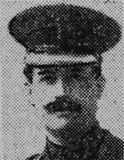
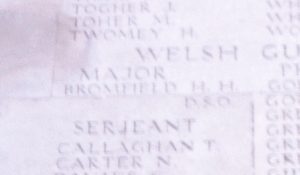
John Charles Bywater, Private, 40082, South Wales Borderers. John was the son of George Bywater and Alathea Bywater (nee Sheen), of Llyn, Disserth. He had married Margaret Williams in 1907, and the couple had four children. John enlisted at Knighton into the Monmouthshire Regiment, and after his training was posted to France, joining the 6th Battalion, South Wales Borderers, which was the Pioneer battalion to the 30th Division. He probably joined the battalion following the Divisions efforts on the Somme in 1916. In March 1917 the Division followed the German Retreat to the Hindenburg Line, and in April took part in the First and Second Battles of the Scarpe. Later that year the Division moved north to Ypres, and fought at the Battle of Pilckem. At the beginning of 1918 the Division was stationed near St. Quentin, and took part in heavy fighting following the German Spring Offensive of 21 March 1918. The depleted Division was then withdrawn from the line and moved to Flanders, but was caught up in the action again here when the Germans launched a fresh offensive along the Lys. The Division moved to the Aisne sector in May, and got caught up in another German offensive, the final one of the war. John was killed in action during heavy fighting near Hermonville on 28 May 1918, aged 32. He has no known grave and is commemorated on the Soissons Memorial, France.
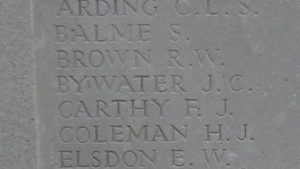
John Charlton, Private, S/11326, Argyll and Sutherland Highlanders. John appears to have been born as John Lewis in 1887. He was adopted by Robert John Charlton and Agnes Charlton. His father was a gardener at Doldowlod. John enlisted at Dunfermline into the Argyll and Sutherland Highlanders and landed in France on 1 October 1915, before being posted to the 2nd Battalion, Argyll and Sutherland Highlanders, which was attached to 19 Brigade. The brigade was by then attached to the 2nd Division but on the following month was attached to the 33rd Division. The Division had moved to France during November 1915, and saw its first major action during the Battles of the Somme, from July 1916 onwards. Early in 1917 it had moved to the Arras sector in readiness to take part in the forthcoming Battle of Arras. The battle opened on 9 April 1917 and the most famous success was to the north, with the successful Canadian assault on the Vimy Ridge. John was killed during the Second Battle of the Scarpe, on 24 April 1917aged 29. He has no known grave and is commemorated on the Arras Memorial, France. John is also commemorated on the Llanyre war memorial.
Arthur Richard Curtis, Private, 355054, Royal Welsh Fusiliers. Arthur was born in Faringdon, Berkshire in 1886, the son of George Richard Curtis and Annie Curtis (nee Evans). His mother was from Rhayader, and Arthur and his four siblings often stayed with family in the town before the family came back home to live at Penporth House, Church Street. Arthur married Ellen Search at Burford, Oxfordshire on 13 July 1905, and the couple went to live at Seven Sisters, near Neath, where Arthur had found work as a coalminer, but soon afterwards the couple had moved to Church Street, Rhayader, where Arthur had found work as a Groom. Arthur enlisted into the Montgomeryshire Yeomanry at Rhayader on 12 January 1912, and attended the annual summer camp over the coming years. On 5 August 1914 the Montgomeryshire Yeomanry was mobilised at Welshpool, as part of the South Wales Mounted Brigade, before moving via Hereford to Thetford, to join the 1st Mounted Division. On 4 March 1916 the 1st Mounted Division sailed for Egypt to join the EEF, and soon afterwards the Montgomeryshire Yeomanry merged with the Welsh Horse Yeomanry to form the 25th (Montgomery & Welsh Horse Yeomanry) Battalion, Royal Welsh Fusiliers, as part of the newly formed 231 Brigade, 74th (Yeomanry) Division. The Division then took part in the Second Battle of Gaza, which resulted in a defeat by the Turks, before the EEF placed under the command of Sir Edmund Allenby, who reorganised his new command, before launching a third offensive against Gaza on a wider front, running from Gaza to Beersheba, on 1 November 1917. This time the EEF broke the Turkish lines, opening the way to Jerusalem, and captured the Holy City on 9 December. The EEF then continued its advance northwards over the coming months. Arthur was wounded in both legs by machine-gun fire during the advance through the Judean Hills, near Balua Lake on 9 March, and died of his wounds on 12 March 1918, aged 42. He is buried in Jerusalem War Cemetery, Israel. A brother, John, had died in Salonika in 1917.
John Herbert Curtis, Gunner, 170610, Royal Field Artillery. John was born in Faringdon, Berkshire in 1898, the son of George Richard Curtis and Annie Curtis (nee Evans). His mother was from Rhayader, and Arthur and his four siblings often stayed with family in the town before the family came back home to live at Penporth House, Church Street. John assisted with his father’s fish business prior to enlisting at Rhayader into the Royal Field Artillery. After completing his training, he was posted to A Battery, 98th Brigade, Royal Field Artillery, which was in Salonika attached to the 22nd Division. John had not been in Salonika long when he took ill, and died of sickness, probably malaria, on 6 August 1917, aged 19. He is buried in Sarigol Military Cemetery, Kriston, Greece. His brother Arthur died of wounds in Palestine the following year.
Albert Davies, Corporal, 21117, Lancashire Fusiliers. Albert was born in Mansfield, Nottinghamshire in 1894, the son of John and Kate Davies. His father was from Rhayader, and Albert had spent a lot of time in the town staying with family over the years. He enlisted into the King’s Shropshire Light Infantry soon after the outbreak of war, and was posted to Prees Heath Camp, in Shropshire, for training. He married Ivy Sherman, of nearby Whitchurch, in 1917. Soon after their marriage, Albert embarked for France, and was transferred to the 17th Battalion, Lancashire Fusiliers. The battalion was attached to 104 Brigade, 35th Division, and Albert probably joined it in the Gillemont sector, north of Péronne, where the Division was in positions facing the Hindenburg Line. On 2 October 1917 the division began to move north, entraining at Péronne for Esquelbecq, and on 17 October the 17th Lancashire Fusiliers moved into the front line at Ypres, the war diary noting ‘conditions extremely bad’, with much of the line comprising of shell-holes full of water. At dawn on 22 October, the battalion went over the top, rising from the shell-holes the men had been waiting in, and launched an assault against the German lines. The assault initially went well, but the right flank of the battalion was wide open, and the Germans launched a vicious counter-attack. Albert was wounded during the days fighting, and was evacuated to a Casualty Clearing Station at Proven, where he died of his wounds on 27 October 1917, aged 23. He is buried in Dozinghem Military Cemetery, Belgium.
Benjamin Davies, Private, 41265, South Wales Borderers. Benjamin was the son of Evan Davies and Margaret Harriet Davies (nee Bage), of Woodside Cottage, Penybont Station. He enlisted into the Welsh Regiment, but after being drafted to France in the summer of 1917, was transferred to the 12th Battalion, South Wales Borderers, which was attached to 119 Brigade, 40th (Bantam) Division. He probably joined the battalion at Gonnelieu, where the Division was holding a section of front line facing the mighty Hindenburg Line. The infantry battalions of the division were carrying out the usual routine of trench rotation, in what was at the time a relatively peaceful sector. On 7 October the battalion moved to billets in Doingt, and the entire division moved to Gouy-en-Artois, to carry out a system of training, in preparation for the forthcoming Battle of Cambrai. The 40th Division remained here for several weeks before moving back to the battle area, and during the night of 21 November moved into positions at Doignies, before advancing to Graincourt, in readiness to launch an assault on Bourlon Wood. At dawn on 23 November 1917, supported by tanks, 119 Brigade assaulted Bourlon Wood, the 12th SWB on the left in conjunction with the 19th RWF. The 12th SWB met heavy resistance, so the 18th Welsh were sent forward to assist. Heavy fighting raged throughout the day, and many casualties were suffered. Benjamin was killed in action at some time during that first day of the battle, 23 November 1917. The 19-year-old has no known grave and is commemorated on the Cambrai Memorial, Louverval, France. He is also commemorated on the Penybont war memorial.
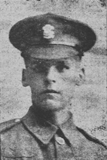
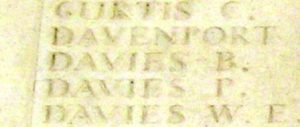
John Garnet Gordon Davies, Private, 33767, King’s Shropshire Light Infantry. John was the son of Thomas and Elizabeth Davies, of Busnant Farm, Nantmel, Radnorshire. He enlisted at Llandrindod Wells into the King’s Shropshire Light Infantry at some time in 1916 and after completing his training, was posted to the 7th Battalion, King’s Shropshire Light Infantry, which was attached to 76 Brigade, 3rd Division. John had probably been in France early enough to take part in the Divisions actions during the Battle of the Somme, during the summer of 1916. In May 1917 the Division was at Arras, and took part in the First and Second Battles of the Scarpe, the Battle of Arleux and the Third Battle of the Scarpe, where it captured the heavily defended village of Roeux. The Division then moved north to the Ypres Salient, and fought in the Third Battle of Ypres, at the Battle of the Menin Road and the Battle of Polygon Wood. John was invalided home with trench fever around this time, and upon recovering, was posted back out to France in July 1918, re-joining the battalion at Locon, in the Ypres Salient, where it was rebuilding following heavy losses during the German Spring offensive. The Division was relieved by the 19th (Western) Division soon after John arrived, and moved into the back areas for training. On 21 August 1918 the Allies launched a massive offensive along the Western Front, and the 3rd Division, which had moved back into the front line in the Arras sector, launched its opening assault against Courcelles. After a short rest, the 7th KSLI went back into action, assisting in the capture of Lagnicourt on 3 September, where it suffered terrible casualties. At dawn on 27 September 1918 the 7th KSLI took part in the assault on the Canal du Nord, and came under heavy machine-gun and artillery fire, with the Germans also using gas shells. John was killed by machine-gun fire during the assault that morning. The 20-year-old was buried in Lowrie Cemetery, Havrincourt, France on the following day, by a burial party from his battalion.
John Morgan Davies, Private, 38513, Royal Welsh Fusiliers. John was the son of Ann Davies, of 4, Brookland Cottage, Cefnllys. He married Margaret Ann Evans at Holy Trinity Church Cefnllys on 30 April 1913 and the couple moved to Bargoed, where John had found work as a Collier. He enlisted at Bargoed into the 16th (Cardiff City) Battalion, Welsh Regiment on 25 February 1915 and was posted to Colwyn Bay to train with the battalion. The 16th Welsh embarked for France with the 38th (Welsh) Division on 2 February 1915, but John remained in Britain, transferring to the 2nd (Garrison) Battalion, Royal Welsh Fusiliers. He embarked with the battalion at Devonport on 6 March 1916 for service in Alexandria. After four months in Egypt he was posted to the BEF in France, embarking at Alexandria on 12 July 1916 and upon arrival in France joined the 10th Battalion, Royal Welsh Fusiliers. The battalion was attached to 76 Brigade, 3rd Division and was on the Somme at the time John arrived and had taken part in terrible fighting in Delville Wood. John joined up with the battalion in tents at Mericourt l’Abbe. On 14 August the battalion marched out of camp to Talus Bois and on 16 August 1916 took over the line at Casement and Dublin Trenches. John was unfortunately one of three men killed when the 10th RWF took over their new positions that day. He was 38 years old and is commemorated on the Thiepval Memorial, France. He is also commemorated on the Llandrindod Wells and Llanyre war memorials.
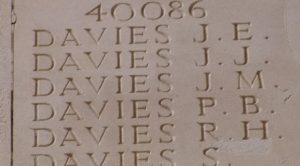
John Rees Davies, Private, 269540, Royal Engineers. John was born on 29 December 1877, the son of Isaac and Sarah Davies, of Oakfield House, Llanafon. He married Mary Samuel in 1901 and the couple set up home at 33, Wye View Terrace, Builth Road, where their two sons were born. John worked for the London and North Western Railway, at their engineering department at Builth Road prior to the war. He enlisted into the Royal Engineers and was posted to the 343rd Road Construction Company, RE in France. By the summer of 1917 John’s Company was attached to XIX Corps, at Ypres. The Third Battle of Ypres opened on 31 July 1917 and the Company would have been employed in building and repairing roads in order to keep the flow of men and material flowing to the front lines. He was wounded within a couple of days of the launching of the offensive and died of his wounds at the 17th Casualty Clearing Station, Lijssenthoek on 8 August 1917, aged 39. John is buried in Lijssenthoek Military Cemetery, Belgium.
Ralph Llewellyn John Davies, Second Lieutenant, Royal Air Force. Ralph was the son of Llewellyn and Winifred Davies of The Firs, Rhayader. Educated at Llandovery College from 1911 to 1917, Ralph joined the Royal Air Force, and was posted to 89 Squadron, which was a Training Squadron, based at RAF Netherchurch, Wiltshire. Ralph was killed in a training accident on 5 May 1918, at Netherchurch, when he crashed whilst flying Sopwith Camel D9544 whilst target training. He was just 18 years old, and is buried in the churchyard of St. Winifred’s Church, Llansantffraid Cwmdauddwr, Powys.
Thomas Davies. This man cannot presently be identified.
George Francis Hermitage Day, Second Lieutenant, Royal Field Artillery. George was born at Abbeycwmhir in 1895, the son of Reverend Ernest Hermitage Day and Mrs Doris Elinor Day (nee Philips). He was commissioned into the Royal Field Artillery in February 1916 and was posted to the 125th Battery, Royal Field Artillery, which was attached to the 4th Division. George arrived in France soon after being commissioned, joining the battery on the Somme, where it was preparing to take place in the forthcoming Somme offensive, which was launched on 1 July 1916. George was then attached to the 42nd Siege Battery, Royal Garrison Artillery, which was also in the Somme sector. On 10 September 1916 George was working his way into an advanced position, together with his telephonist, Gunner John Leck (66509), when both men went missing. George was officially recorded as being missing, presumed killed in action that day. He was 20 years old and is commemorated on the Thiepval Memorial, France.
David Evans, Private, 235774, Herefordshire Regiment. David was born out of wedlock at St. Harmon as David Evans, the son of Eliza Ann Evans. His mother married Aaron Hope in 1894 and the couple set up home at Abbeycwmhir, where two other sons were born. By 1901 the family had moved to Wernddu Cottage, Nantmel and a further three daughters and one other son were born, before the family moved again, to 5, Brookland Road, Llandrindod Wells. David lived at Cefnfaes Farm, Rhayader for several years prior to the war, where he worked as a farm servant. He enlisted at Hereford into the Herefordshire Regiment, and was posted to their 1/1st Battalion, which was attached to the 53rd (Welsh) Division. On 16 July 1915 he embarked at Devonport with the battalion, aboard the SS Euripides, which set course for Port Said. On the morning of 9 August 1915, the battalion landed at ‘C’ beach at Suvla Bay, Gallipoli, taking part in heavy fighting over the coming days. The battalion remained on Gallipoli until being evacuated on 12 December 1915 and moved to Egypt with the division. The division guarded the Suez Canal line for over a year, before taking part in the advance into Palestine, and saw heavy fighting during the First Battle of Gaza on 26 March 1917. David was wounded and taken prisoner during the battle and died in captivity the following day, 27 March 1917, aged 27. He has no known grave and is commemorated on the Jerusalem Memorial, Israel. His two half brothers, John Hope and Edward Aaron Hope, also fell during the war, and all three men are commemorated on the Llandrindod Wells war memorial.
Henry Evans, Private, 25716, King’s Shropshire Light Infantry. Henry was the son of John and Margaret Evans, of Tyniclos, Pantydwr. He resided at Rhayader prior to the war and enlisted there into the King’s Shropshire Light Infantry. After completing his training, Henry was drafted to France, joining the 1st Battalion, King’s Shropshire Light Infantry, which was attached to 16 Brigade, 6th Division. Henry would have joined the battalion at some time in 1916, while the Division was on the Somme. The Division took part in the Battle of Flers-Courcelette, which was the first time that tanks were used in action. The Division then took part in further fighting during the Battle of Morval and the Battle of Le Transloy. Towards the end of October 1916, the Division began to move away from the Somme sector to Bailleul, and then moved to Bethune, before taking over a section of front-line west of Givenchy. The Division then held a section near Vermelles, and its infantry battalion were carrying out the usual routine of trench rotation. On 4 October 1917 the 1st KSLI moved back into the trenches north of Lens, to begin a routine tour in trenches some 200 yards south of the Lens to Bethune road. Henry was wounded during this spell in the line, and died of his wounds on 9 October 1917, aged 29. He was buried in Lapugnoy Military Cemetery, France.
John Evans, Private, 266739, Monmouthshire Regiment. John was born at Hope Bowdler in 1886, the son of Thomas and Mary Evans. On 3 April 1910 he married Alice Ann George, of Cwmgiver Cottage, Abbeycwmhir, where he worked as a waggoner. John enlisted into the Monmouthshire Regiment at Hereford on 11 December 1915 and on 11 June 1916 joined its 2nd Reserve Battalion at Pontypool. He arrived in France on 4 December 1916 and was posted to the 2nd Battalion, Monmouthshire Regiment, which was by then the Pioneer battalion to the 29th Division. The division was by then back on the Somme, near Montauban. The 2nd Monmouth’s remained in this sector over the winter and by 20 February 1917 had a number of men at work building galvanised iron huts near Hardecourt Camp and more building trench mortar positions at a location called Wedgewood. This work was still continuing on 23 February 1917 when the working party that John was with was caught up in German artillery fire, killing John and two other men in the village of Sailly-Saillisel. John was 33 years old when he died that day, and is buried in Sailly-Saillisel British Cemetery, France.
Reginald Evans, Private, 8194, Herefordshire Regiment. Reginald was the son of Thomas and Mary Evans, of Caerherbert Lane, Rhayader. He worked as a labourer prior to the war. Reginald had enlisted into the 1st Battalion, Herefordshire Regiment at some time prior to the war. The battalion mobilised for war at The Barracks, Hereford, as part of the Welsh Border Brigade, Welsh Division and moved to its war station at Pembroke Dock. On 10 August the battalion moved to Oswestry, before joining the Welsh Division at Bedford in May 1915. The Division was then numbered the 53rd (Welsh) Division. On 19 July 1915 the entire Division sailed from Devonport for Imbros and on 9 August 1915 landed at Suvla Bay. The infantry moved off the beaches into the bush, but due to a lack of maps and no knowledge of the terrain, many of the units became disorientated, and the situation became chaotic. The situation settled down over the coming days, but was still precarious, with the Division coming under almost constant artillery and sniper fire. Reginald survived the chaos which followed the landings, but became ill towards the end of the campaign, contracting dysentery and frostbite, and was evacuated from Gallipoli, returning home towards the end of the year. On 17 March 1916 he left the army, time expired, but re-enlisted into the 3/1st Battalion, Herefordshire Regiment on 16 August 1916, and was posted to Oswestry. His health had by now began to suffer from the harsh conditions at Gallipoli, and Reginald was discharged from the army as medically unfit on 8 December 1916. He returned home to Rhayader where he died of tuberculosis on 6 February 1918, aged 23. Reginald was buried in St. Clement’s Churchyard, Rhayader.
William Edward Sylvester Evans, Gunner, 128524, Royal Garrison Artillery. William was the son of Thomas and Elizabeth Evans, of Clarance House Rhayader. He worked for his father, a saddler, prior to enlisting into the Royal Garrison Artillery on 21 October 1916, and was posted to A Siege Depot, Royal Garrison Artillery for training. During the summer of 1917 William began to suffer with his health, and was discharged from the army on 24 August 1917, suffering from osteoarthritis in his right hip. He returned home to Rhayader where he died, probably of tuberculosis, on 16 September 1919, aged 22. William is buried in St. Clement’s Churchyard, Rhayader.
Frederick Farmer, Private, 27744, Border Regiment. Frederick was the son of Evan Farmer and Mary Farmer (nee Lewis), of Criggin, Nantmel. He enlisted at Rhayader into the Herefordshire Regiment and was posted to France in 1916, joining the 11th Battalion, Border Regiment. The battalion had been raised by the Earl of Lonsdale in September 1914 and landed in France on 23 November 1915 attached to 97 Brigade, 32nd Division. The division moved to the Somme sector and on 1 July 1916 took part in the opening offensive of the Battle of the Somme from their positions between Authille Wood and Thiepval Wood, but suffered terrible casualties before the survivors of the division were withdrawn. The Lonsdale’s were in camp at La Vicogne at the beginning of November 1916 and on 13 November began to move forwards towards the front line at Redan Ridge, reaching their positions on the 17th and began to prepare to launch an assault on the following morning. At 6.10 on the morning of 18 November 1916 the Lonsdale’s arose from their trenches and began to advance on the German line at Munich Trench under very heavy machine-gun and artillery fire. Frederick was among many men killed during the assault that day. He was 18 years old and is commemorated on the Thiepval Memorial, France. Frederick is also commemorated on the Nantmel war memorial.
Thomas Francis, Private, 18035, King’s Shropshire Light Infantry. Thomas was born at Court Bytake, Montgomery in 1894, the son of Thomas Francis and Susannah Francis (nee Williams), and was baptised at Montgomery on 12 July 1894. His father was an agricultural worker and shepherd, and over the coming years the family moved several times, including to Upper Barn Cottage, New House, Shipton, Much Wenlock; The Outtrack, Craven Arms; and later to The Tally Ho, Boulden, Diddlebury, Craven Arms. Thomas had worked at Tryfal, Nantmel and at Nantymynach, Nantmel prior to enlisting at Shrewsbury together with his elder brother William into the King’s Shropshire Light Infantry on 24 May 1915, and after training at Pembroke Dock, the brothers embarked for France on 27 October 1915, before being posted to the 7th Battalion, King’s Shropshire Light Infantry. The battalion had only been in France a month, initially attached to 76 Brigade, 25th Division, but by the time the brothers joined its ranks, was at Ypres attached to 8 Brigade, 3rd Division, the Division having been relieved from the Sanctuary Wood sector a week earlier, moving to a rest camp in the Steenvoorde area. On 23 November the Division moved back into the line, taking over the section running between St. Eloi and Hill 60, and the 7th KSLI marched to Reninghelst that day, in Divisional reserve. The new sector was situated just south of the Ypres-Commines canal in the southern neck of the salient, the line facing roughly south-east. Headquarters of the 7th KSLI was situated in Spoil Bank and the feature known as The Bluff was on the opposite bank of the canal. The battalion remained here over the coming months, rotating in the front line with the 1st Northumberland Fusiliers until early February 1916, when the Division moved to Eperlecques for a rest. Less than two weeks later, on 14 February, the Germans launched an offensive against the Ypres Salient, capturing The Bluff, so the 3rd Division was ordered back into the line to recapture the lost ground. On 2 March 1916, 8 Brigade supported an assault by 76 Brigade against The Bluff, an action which saw the 10th RWF, in the latter Brigade, decimated. The 7th KSLI took over the new front line, which it consolidated, before being relieved on the night of 7-8 March, and moved back to Reninghelst. On 11 March the battalion moved back into its old sector on the Spoil Bank south of the canal, and on 19 March took up reserve positions for an assault by 9 Brigade on the Mound at St. Eloi, remaining in the sector over the coming weeks. Thomas was killed at St. Eloi on 3 April 1916, just hours before the 7th KSLI was relieved. The 23-year-old has no known grave and is commemorated on the Ypres (Menin Gate) Memorial, Belgium. His brother, William, had been wounded at St. Eloi and had died of his wounds the previous day.

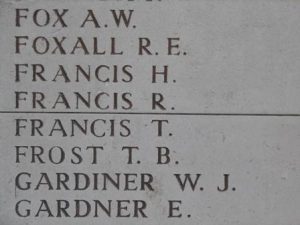
Frederick Arthur Bowen Hamer, Private, 2283, Royal Fusiliers. Frederick was the son of William Bowen Hamer and Eda Blanche Hamer, of Hazelmere, Rhayader. He worked as a bank clerk prior to the war. Frederick enlisted into the 26th Battalion, Royal Fusiliers soon after the outbreak of war. The battalion was known as the Bankers Battalion, and had been raised by the Lord Mayor and City of London from 17 July 1915, from Bank Clerks and Accountants. The battalion moved to Aldershot joining 124 Brigade, 41st Division and on 4 May 1916 embarked for France. The Division moved to the areas of Ploegsteert and the Douve valley, south of Ypres for trench initiation, and remained here until August 1916, when it was moved to the Somme, taking part in the Battle of Flers-Courcelette. The Division remained in the line, pushing on to Courcelette over the next few days before coming out for a rest and re-fit. The Division then fought at the Battle of Le Transloy, before moving to positions south of Ypres, at St. Eloi, in 1917. Here the Division took part in the Battle of Messines Ridge in June 1917, before moving to the Meteren area for training and rebuilding. It then moved back into the line in the Ridge Wood sector at the end of July, in preparation to take part in the opening offensive of the Third Battle of Ypres, which was launched on 31 July 1917. The Division took part in heavy fighting over the coming weeks, as the Battle of Passchendaele raged. On 19 September 1917 the 26th Royal Fusiliers moved into positions at Voormezeele, in readiness to carry on the offensive, and at dawn the following day, 20 September 1917, launched an assault on the Tower Hamlets Ridge, suffering over 300 casualties during the days fighting. Frederick was killed at some time during the fighting that day. The 24-year-old has no known grave and is commemorated on the Tyne Cot Memorial, Belgium.
Samuel Hamer, Private, 441801, Labour Corps. Samuel was the son of George and Mary Hamer, of Rhayader. He married the widowed Clara Agnes Lewis (nee Morgan), also of Rhayader, in 1914, and the couple lived at 3, Rose Cottage, Godrergraig, Swansea Valley. Samuel enlisted into the Brecknock Battalion, South Wales Borderers on 13 October 1914 and remained on home service until embarking for France on 1 August 1917, after being transferred to the Monmouthshire Regiment, and joined the 1/2nd Monmouth’s. The battalion was by then the Pioneer Battalion to the 29th Division at Ypres. Samuel was transferred to the Labour Corps on 12 November 1917, and remained on the Western Front over the coming months, but his health began to break down and he was taken to the 46th General Hospital at Étaples. He returned to Britain on 30 May 1918 and was taken to the 2nd Western General Hospital at Manchester, where he was found to have contracted tuberculosis. Samuel was discharged from the army as medically unfit on 16 September 1918, and returned to Godrergraig, where he died of tuberculosis on 22 October 1918, aged 42. Samuel was buried in Holy Trinity Churchyard, Godrergraig.
Albert Edward Hughes, Private, 3110, Montgomeryshire Yeomanry. Albert was the son of Edward and Rosetta Maud Hughes, of Glasllyn Lodge, Nantmel. He enlisted at Rhayader into the 2/1st Battalion, Montgomeryshire Yeomanry and was posted to Ireland with a number of other men from the regiment, joining the 6th Reserve Cavalry Regiment at The Curragh. Albert took ill and died of meningitis on 6 September 1915, just three months after arriving at The Curragh. He was 19 years old and is buried in St. Bridget’s Cathedral Cemetery, Kildare. He is also commemorated on the Nantmel War Memorial.
Edward Griffiths Hughes, Private, 203710, Gloucestershire Regiment. Edward was born on 9 November 1894, the son of Evan and Elizabeth Hughes, of St. Harmon, Radnor. He married Elsie May Pugh, of Nantmel, in 1916. Edward enlisted at Hereford into the Herefordshire Regiment, and after completing his training was posted to France, joining the 1/5th Battalion, Gloucestershire Regiment, which was attached to 145 Brigade, 48th (South Midland) Division. He probably joined the battalion on the Somme in the summer of 1916, following heavy losses during the opening of the Battle of the Somme. The Division then went back into action at the Battle of Bazentin, during the second phase of the Battle of the Somme, and captured Ovillers. It then fought at the Battle of Pozieres and the Battle of the Ancre. In March 1917 the Division followed the German Retreat to the Hindenburg Line, advancing from its positions at Cappy towards Villers-Faucon and Lempire. The Division then moved to positions around Hermies, in the Cambrai sector, and on 22 July entrained for Godewaersvelde, before moving into the Ypres Salient, observing the launch of the Third Battle of Ypres from its new camp at St. Jan ter Biezen on 31 July. By 5 August the Division was in Ypres, marching through the ruined city before taking over positions east of the Steenbeek near St. Julien. At dawn on 16 August 1917 the 1/5th Gloucester’s took part in an assault on Border House, before attacking gun positions to the north and south of the St. Julien road. Edward was badly wounded during the morning and died of his wounds that same day. The 22-year-old has no known grave and is commemorated on the Tyne Cot Memorial, Belgium.
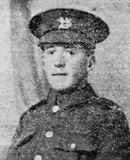
Evan Ingram, Private, 13109, Devonshire Regiment. Evan was the son of Richard and Harriett Ingram, of Hirfron Farm, Pantydwr. He lived at 39, Frederick Street, Ferndale prior to the war, and worked there as a Grocers Haulier. Evan enlisted at Pentre into the 9th Battalion, Devonshire Regiment soon after the outbreak of war. The battalion formed at Exeter before moving to Rushmoor Camp, Aldershot as Army Troops, 20th Division, but upon embarking for France on 8 August 1915, joined 20 Brigade, 7th Division at Calonne sur-la-Lys. The battalion then moved to Fouquereuil, before moving to the front and taking up positions at Vermelles on 25 September, the opening day of the Battle of Loos. The battalion, new to the Western Front, was immediately thrown into action, assaulting the Breslau Trench. Heavy fighting raged all day, and then at midnight the Germans counter-attacked. Reserve troops came forward at dawn to bolster the weakened battalion, and fighting continued throughout the second day, until the 9th Devon’s were relieved that night, moving back into support trenches. Over the coming days, the battered battalion remained in support, digging new trenches and consolidating captured trenches, all the time under heavy fire. Evan was killed in action here on 30 September 1915, aged 27. He has no known grave and is commemorated on the Loos Memorial, France.
Abraham Jones, Private, 270558, Canadian Infantry. Abraham was born on 11 April 1886, the son of Abraham and Sarah Jones, of Rhayader. He emigrated to Canada in 1906, and resided at Waterford Ontario, where he worked as a sheet metal worker, and he married Lilian Farmilo at Brantford, Canada prior to the war. Abraham was a member of the local Brant Militia when he enlisted into the 215th Overseas Battalion, Canadian Infantry at Brantford, Ontario on 8 August 1916. On 28 April 1917 he embarked for England, and disembarked on 7 June, entraining from Liverpool to Otterpool with his battalion. He was then posted to the Canadian Depot at Witley and on 8 April 1918 embarked for France, joining the 38th Battalion, Canadian Infantry. The battalion was attached to the 12th Brigade, 4th Canadian Division, and had just moved from Neuville St. Vaast to the Oppy Sector, near Maroeuil, due to the pressure being put on the Allied line as a result of the German offensive which had been launched on 21 March. By now, German attention had turned to their offensive along the Lys Valley, so the Canadian Corps enjoyed a relatively peaceful few months before moving to the southern part of the Somme sector, and on 8 August 1918 took part in the Battle of Villers-Bretonneux, an action which broke the spirit of the German army. From 21 August onwards the Allies launched a massive offensive along the Western Front, and the Canadians, moving back to the Arras sector, took part in this great advance. On 29 September 1918, Abraham’s company was advancing against an enemy strong-point in front of a sunken road, some 200 yards from the Douai to Cambrai Road, when Abraham was shot in the face and killed. The 32-year-old is buried in Bourlon Wood Cemetery, France.
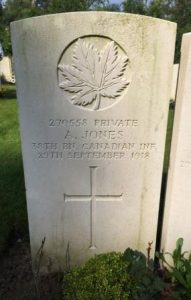
David Leonard Jones, Private, 201801, Welsh Regiment. David was the son of Thomas and Jane Jones, of Gigrin Farm Rhayader. He worked on his father’s farm prior to the war. David enlisted into the 4th Battalion, Welsh Regiment, and after completing his training, was posted to Egypt, before joining the 1/4th Battalion, Welsh Regiment. The battalion was attached to 158 Brigade, 53rd (Welsh) Division, which had been evacuated from Gallipoli in December 1915, moving to Egypt to join the EEF, and helped guard the Suez Canal before taking part in operations to drive the Turks out of the Sinai. The EEF then turned its attention onto driving the Turks out of Palestine, and on 26 March 1917 launched its first offensive against the coastal city of Gaza, which guarded the road to Jerusalem. Initial gains during the day were lost when the assaulting divisions lost touch with each other and communication broke down when a thick fog cloaked the battlefield. A second attempt to force Gaza was launched on 17 April, which also failed, and the EEF suffered a change in leadership, with Sir Edmund Allenby assuming command, before being re-organised, and a third offensive was launched against a wider front from Beersheba to Gaza on 31 October 1917. This time the Turkish defences were breached, and the road to Jerusalem now lay open and the EEF began to advance north. On 6 November 1917, 158 Brigade launched an attack on the Khuweilfeh Heights, and once secured, the EEF continued its advance into the Judean Hills, the 53rd Division capturing Hebron and Bethlehem, before securing the Jerusalem to Jericho road. Allenby finally made his triumphant entry into Jerusalem on 11 December. David survived the rigours of the Palestinian campaign, but soon after his return home, died on 11 April 1919, aged 36. He is buried in St. Bride’s Churchyard, Llansantffraid-Cwmdauddwr.
David Noel Jones, Private, 2009, Welsh Regiment. David was born at Abbeycwmhir in 1890, the son of John George and Matilda Jones. He resided at Pontarddulais prior to the war, and enlisted at Swansea into the 1/6th Battalion, Welsh Regiment. The battalion landed in France on 29 October 1914, and moved to work on Lines of Communication around Calais. On 5 July 1915 it became attached to 84 Brigade, 28th Division, and on 23 October 1915 transferred to 3 Brigade, 1st Division. The Division was at Loos, and it was here on 22 November 1915 that David was killed. He was 25 years old and is buried in Dud Corner Cemetery, Loos, France. David is also commemorated on the Newbridge-on-Wye war memorial.
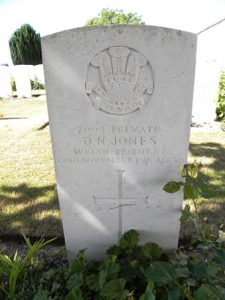
James Jones. James cannot presently be identified, but he is commemorated on the memorials at Nantmel and at Rhayader.
John Owen Jones, Lance Corporal, G/67398, London Regiment. John was the son of Philip and Margaret Jones, of Rhayader. He married Edith Evelyn Fowler, of Brynmawr, on 25 February 1907, and the couple set up home at 6, Dumphries Place, Brynmawr, where their two daughters were born. John enlisted into the Army Service Corps at Cardiff, but after completing his training was transferred to the 2/2nd Battalion, London Regiment (Royal Fusiliers), which was attached to 169 Brigade, 56th (London) Division. The Division moved to the Somme and fought at the diversionary attack on Gommecourt then at Ginchy, Flers and Morval, where it captured Combles. The Division wintered on the Somme, and followed the German retreat to the Hindenburg Line in March 1917 before fighting in the Battle of Arras. It then moved to Ypres, where they fought at Langemarck, then moved south and fought at the Battle of Cambrai in October 1917, remaining in the area for the winter, in positions near Bancourt, before moving to the Gavrelle sector in mid-February 1918. By 18 March 1918 it had become obvious that the Germans were preparing to launch an offensive, then at dawn on 21 March 1918 a massive artillery bombardment, along the section of front running from Croisilles to La Fère, broke the silence, hammering the British front and support lines. The bombardment was following by a wave of German shock troops, which hit the line, and ferocious, desperate, fighting erupted. The 56th Division, holding the Gavrelle sector, was hit hard, suffering severe casualties over the coming days. John was killed in action during the opening day of the offensive, 21 March 1918. The 33-year-old is buried in Chauny Communal Cemetery British Extension, France.
Joseph Jones. Joseph cannot presently be identified, although a John Jones, born in Rhayader in 1896, was killed in France in 1918?
Thomas Jones, Private, 17197, Royal Welsh Fusiliers. Thomas was born on 2 March 1883, the son of Edward and Jane Jones, of Cwmbach Crossing, Rhayader. He lived at 13, Taff View, Abercynon prior to the war, where he worked as a coal hauler. Thomas enlisted into the 16th Battalion, Royal Welsh Fusiliers at Pontypridd soon after the outbreak of war. The battalion was raised at Llandudno by the Welsh National Executive Committee from a cadre from the 13th Battalion, joining 128 Brigade, 43rd (Welsh) Division and trained in North Wales before moving to Winchester in the summer of 1915, where the formation became renumbered 113 Brigade, 38th (Welsh) Division. The Division moved to France on 2 December 1915 and moved to the Nursery Sector near Fleurbaix for trench initiation alongside the Guards Division. The Division then held a sector of the line near Cuinchy before marching south to the Somme sector in June 1916 to take part in the assault on Mametz Wood. The first attack on the wood was launched on a two-battalion front on 7 July, but failed, and the Divisional Commander, Sir Ivor Philipps, was replaced before the Division attacked again on a two Brigade front on 10 July 1916. After two days of ferocious hand-to-hand fighting, the wood was cleared up to its northern edge, before the battered Division was relieved. It then took over a section of the front at Hébuterne before moving to the Ypres Salient, and taking over the Canal Bank sector at Boesinghe. The infantry battalions of the Division then began carrying out the normal pattern of rotation in the trenches, four days in the front, four in support and four in reserve, whilst also working on trench improvement, digging new trenches, and also carrying out regular patrols and trench raids. On 31 July 1917 the Division launched its famous assault on the Pilckem Ridge, capturing Iron Cross and reaching its objective of the Steenbeek, then played a supporting role in the Battle of Langemarck. The Division was transferred to the Sailly-sur-la-Lys sector in September, and remained in the area over the winter before being moved to positions north of Albert, at Bouzincourt Ridge, at the end of March 1918, relieving the battered 2nd and 47th Divisions. It held this sector, again carrying out minor operations and trench raids, over the coming months, before taking part in the great offensive of 21 August 1918, and began its advance towards the Hindenburg Line. On 18 September 1918 the Division attacked the village of Gouzeaucourt, and Thomas was killed in action that day, during the attack on African Trench. The 35-year-old has no known grave and is commemorated on the Vis-en-Artois Memorial, Haucourt, France.
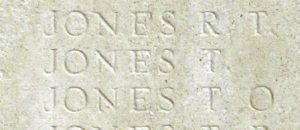
Thomas Jones, Lance Corporal, 5040, Scots Guards. Thomas was the son of Thomas and Ann Jones, of 3, Castle Row, Rhayader. He had moved to South Wales to find work as a coal hewer, and married Mabel Annie Weaver in 1908. The couple lived at 12, Bishop Street, Penygraig. Thomas had served in the local Militia at some time, and enlisted at Shrewsbury into the Scots Guards soon after the outbreak of war. He was posted to France on 22 September 1914, joining the 1st Battalion, Scots Guards, which was attached to 1st (Guards) Brigade, 1st Division. He probably joined the battalion at Vendresse, where the BEF had retreated following the Battle of Mons. On 17 October the 1st Division entrained for Northern France with the BEF, and the 1st Division moved to Hazebrouck before moving into the Ypres Salient, and saw heavy fighting at the First Battle of Ypres, where it helped stop the German drive towards the Channel ports. The Division wintered in Flanders, and the following spring took part in the Battle of Aubers Ridge, before moving South to the Loos sector and on 25 August 1915 the Scots Guards joined the newly formed Guards Division. On 27 September the Guards Division joined the action at the Battle of Loos. The Guards suffered heavy casualties at Loos, but remained in the sector over the winter before moving to positions in reserve, near Calais, then moved to the Ypres Salient for several months before heading south to take part in the Somme offensive. Thomas was wounded at Ypres, just prior to the move south, and was invalided to Britain, before being transferred to Guildford War Hospital in Surrey. He died there of his wounds on 17 July 1916, aged 31. His remains were brought back to South Wales for burial in Trealaw Cemetery, Rhondda.
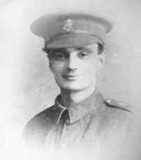
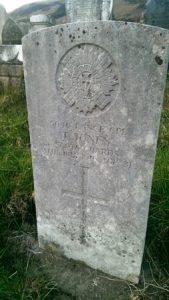
William Gordon Jones, Private, 85385, Durham Light Infantry. William was born at Rhayader on 12 February 1899, the son of William and Annie Jones. Prior to the war the family was residing at Coed Howell, Llanfyllin, and William was still in school when war erupted. He enlisted into the 3rd Battalion, Royal Welsh Fusiliers at Welshpool on 10 November 1917, and after completing his training, embarked for France on 31 March 1918, just ten days after the Germans had launched the first phase of their Spring Offensive on the Somme. William joined the Infantry Base Depot before being transferred to the 1/6th Battalion, Durham Light Infantry, joining the battalion on 19 April 1918. The battalion was attached to 151 Brigade, 50th (Northumbrian) Division, and was in the Lys valley, fighting a desperate rear-guard action following the launching of the second phase of the German offensive there on 9 April. The battered Division was then transferred to the Aisne sector to rest and rebuild, but unfortunately on 27 May 1918 the Germans launched the third, and last, phase of their Spring Offensive here and the 50th Division was again caught up in desperate fighting. William’s battalion was in positions near the Bois Marais when the Germans launched their offensive along the section of front stretching from Soissons to Reims and was hit at dawn. Desperate fighting raged over the coming days as the Allies were driven back, and William was posted as missing at some time between 27 and 31 May 1918. He was later found to have been taken prisoner of war by the Germans, and was brought to a POW Camp in Poland. As happened so often in captivity, due to extreme food shortages in Germany at the time, William’s health suffered, and he died of bronchial catarrh and heart failure at Heilsberg Hospital on 30 October 1918, aged 18. He is buried in Lidzbark Warminski War Cemetery, Poland.
Alfred James Keylock, Private, 46127, Royal Welsh Fusiliers. Alfred was born in 1890, the youngest child of John and Fanny Keylock, of Tewkesbury, Gloucestershire. His parents died soon after his birth, and Alfred and a brother, Ernest, was sent to Mullers Orphanage in Bristol. By 1911 he had been sent to live at Dolfallen, Llanwrthwl, where he had gained work as a cowman, and then prior to the war he was lodging with Richard Price, at Noyadd, Rhayader, working for Mr B. P. Lewis. Alfred received a conscription notice to enlist into the army early in 1916, but his call-up was appealed by his employer, and he was granted exemption until 20 May 1916. Alfred had already served for a year with the Herefordshire Regiment Territorials prior to the war, and stated so when he enlisted into the Royal Welsh Fusiliers on 1 June 1916, giving his next of kin as his sister, Clara Keylock. On 1 September 1916 Alfred embarked for Salonika aboard the HT Franconia, and disembarked on 11 September, joining the 11th Battalion, Royal Welsh Fusiliers, which was attached to 67 Brigade, 22nd Division. The Division had been among a number of French and British units sent to Salonika in 1915 following the Austro-Bulgarian invasion of Serbia, which had resulted in the Serb army being forced to withdraw into Greece. The Allies had then unsuccessfully fought in several large-scale battles against the Bulgarians, the main ones being between 24-25 April and 8-9 May 1917, then on 18 September 1918 at the Second Battle of Doiran. Alfred had survived these major actions, but became ill towards the end of the campaign, and died of malaria and pneumonia at the 48th General Hospital, Salonika on 29 September 1918, aged 28. He was buried in Salonika (Lembet Road) Military Cemetery, Greece. An armistice with Bulgaria was signed on 30 September 1918. An elder brother, William George Keylock, had died of wounds in France in 1914.
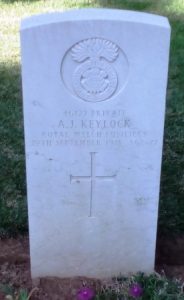
James Leach, Private, TR4/76524, Welsh Regiment. James was the son of Thomas and Martha Leach, of Domen Cottage, Rhayader. He enlisted into the 4th Battalion, Training Reserve in 1918, and was posted to the 53rd (Young Soldiers) Battalion, Welsh Regiment at Kinmel Park after completing his training. James did not go overseas, but remained at Kinmel Park until being demobilised after the Armistice. He returned to Rhayader, but his health had suffered during his time at Kinmel Park, and James died of general debility on 21 December 1920, aged 20. He is buried in St. Bride’s Churchyard, Llansantffraid-Cwmdauddwr. James is not commemorated on the Rhayader war memorial, although his brother, Stephen, who died in 1917, is.
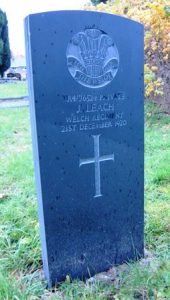
Stephen Thomas Leach, Private, 236547, Herefordshire Regiment. Stephen was the son of Thomas and Martha Leach, of Domen Cottage, Rhayader. He was the second of three sons to enlist into the army following the outbreak of war, enlisting at Hereford into the Herefordshire Regiment. After completing his training, Stephen was posted to Egypt, joining the 1/1st Battalion, Herefordshire Regiment, which was attached to 158 Brigade, 53rd (Welsh) Division. The Division had been evacuated from Gallipoli in December 1915, moving to Egypt to join the EEF, and helped guard the Suez Canal before taking part in operations to drive the Turks out of the Sinai. The EEF then turned its attention onto driving the Turks out of Palestine, and on 26 March 1917 launched its first offensive against the coastal city of Gaza, which guarded the road to Jerusalem. Initial gains during the day were lost when the assaulting divisions lost touch with each other and communication broke down when a thick fog cloaked the battlefield. A second attempt to force Gaza was launched on 17 April, which also failed, and the EEF suffered a change in leadership, with Sir Edmund Allenby assuming command, before being re-organised, and a third offensive was launched against a wider front from Beersheba to Gaza on 31 October 1917. This time the Turkish defences were breached, and the road to Jerusalem now lay open and the EEF began to advance north. On 6 November 1917, 158 Brigade launched an attack on the Khuweilfeh Heights. Stephen was badly wounded during the assault, and died of his wounds that same day, aged 19. He is buried in Beersheba War Cemetery, Israel. His brother, James, died in 1920 as a result of his service during the war.
Gerald Sidney Lewis, Captain, Middlesex Regiment. Gerald was born in Rhayader on 17 July 1895, the son of Sidney Cooke Lewis and Mary Lewis. The family later resided at 3, Hope Park, Bromley, Kent. Gerald was educated at Bradfield College and at Malvern College. He enlisted into B Company of the Inns of Court OTC on 22 Jul 1914, and was commissioned into the Middlesex Regiment on 12 Sep 1914. Gerald was posted to the 11th Battalion, Middlesex, taking command of A Company. The battalion was attached to 36th Brigade, 12th Division, at Colchester, then moved to Shorncliffe. During February 1915 the battalion moved to Ramillies Barracks, Aldershot, then in June 1915 landed at Boulogne. The Division took over the line at Ploegsteert Wood, for trench initiation. They then moved south to Houplines, and on 25 September 1915, the battalion sat in the front line, listening to the sounds of battle raging to their south, as the British had launched the Battle of Loos, and lit pre-prepared fires, before opening fire with rifle and machine-guns, in an attempt to divert German attention away from the main battle. Just days later the Division moved to the Loos sector, taking over positions at Vermelles, and on 14 October launched their own assault. The main battle of Loos had now ground to a halt and, apart from an action at the Hohenzollern Redoubt, normal trench warfare then ensued. During June 1916 the Division left the Loos sector and moved to the Somme, in preparation to take part in the forthcoming Somme offensive. As the Battle of the Somme opened, at 06.20 on 1 July 1916, the Division was in reserve at Baizieux Wood, holding the Albert Defences. On 3 July the Division moved forwards through Authille Wood and took over the front line the following day. On 7 July 1916 the Division launched an assault on Ovillers, in conjunction with the 19th Division. Gerald took A Company across No Man’s Land and entered a recently captured trench, and came into contact with a German strong-point. He led a bombing party against the position, managing to shoot a German dead with his rifle, before he was himself shot dead. Gerald was 20-years-old when he was killed that day, and is buried in Bouzincourt Communal Cemetery Extension, France.
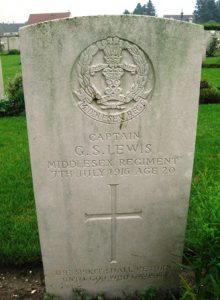
Jason Lewis, Private, 15436, South Wales Borderers. Jason was the son of Thomas and Elizabeth Lewis, of Abbeycwmhir. He worked as a gardener for Doctor John Jones at Clydach prior to the war and in August 1914 attested into the South Wales Borderers. He was not called up straight away, so moved to 25 Cheltenham Road, Greaves, Lancaster after gaining another job, and married Annie Huck in 1915, just before being called up, and joined the 7th Battalion, South Wales Borderers, which was attached to 67 Brigade, 22nd Division. The Division moved to France in early September 1915, and only spent a short period at the front before entraining for Marseilles, where it embarked for Salonika on 27 October 1915. The campaign in Salonika was difficult, as the Allies gained no real success in their campaign against the Bulgarians. The 22nd Division took part in the Retreat from Serbia during December 1915 and fought in several battles: Horseshoe Hill; Machukovo; and the three battles of Doiran. The last major action was during the Third Battle of Doiran, which was launched on 18 September 1918. Jason was killed in action during the fighting that day. He was 37 years old and is commemorated on the Doiran Memorial, Greece. An armistice with Bulgaria was signed on 30 September 1918. Jason is commemorated on at least four known war memorials: at Abbeycwmhir, Pontardawe, Rhayader, and Lancaster. His widow later lived at 16, Wellington Road, Bowerham, Lancaster, with their two children, one from a previous marriage.
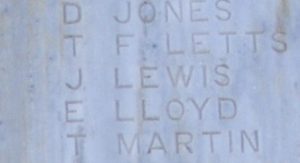
Octavius Hughes Lewis, Private, 17267, King’s Shropshire Light Infantry. Octavius was the son of Thomas and Ann Lewis, of Gilfach, Nantmel. He worked on his father’s farm prior to enlisting at Rhayader into the 5th Battalion, King’s Shropshire Light Infantry, and served with D Company. The battalion was attached to 42 Brigade, 14th (Light) Division and landed at Boulogne on 20 May 1915. The division moved to the Ypres sector and saw its first major action at Hooge, when it became the first British division to be attacked by flamethrowers. The division remained at Ypres over the coming months and on 25 September 1915 took part in a diversionary attack, to attempt to divert German attention away from the offensive which had been launched at Loos that same day. The 5th KSLI launched its attack at 04.20 and managed to penetrate the German second line, but the attack to the right had failed and within four hours the battalion was forced to withdraw, coming under heavy artillery fire. Octavius was among over 400 casualties suffered by the 5th KSLI that day. The 25-year-old has no known grave and is commemorated on the Menin Gate Memorial, Ypres.
Edward Price Lloyd. Edward cannot presently be identified.
Henry Lloyd, Corporal, 13143, South Wales Borderers. Henry was the son of William and Ann Lloyd, of Rhayader. He had moved to South Wales as a young man, and married Elizabeth Ann Edwards in 1899. By 1911, Henry was widowed, and was living with their daughter, Tydfil, at the Half Moon Inn, Ivor Street, Dowlais. Henry enlisted at Newport into the 4th Battalion, South Wales Borderers soon after the outbreak of war. The battalion was formed at Brecon in August 1914, moving to Park House Camp, near Tidworth to join 40 Brigade, 13th (Western) Division. Towards the end of February the entire Division concentrated at Blackdown in Hampshire. On 7 June 1915 orders were received to prepare to move to the Mediterranean. On 13 June 1915 the Division sailed for Alexandria, and moved to Mudros before being landed at Cape Helles, Gallipoli from 6 July 1915, relieving the 29th Division. The Division then left and returned to Mudros at the end of the month, and the entire Division landed at ANZAC Cove between 3 and 5 August 1915, taking part in several major battles in the coming weeks. Henry was wounded during the heavy fighting which followed, where the battalion lost its Commanding Officer and almost 70% of its strength. He died of his wounds on 22 August 1915, aged 47. Henry has no known grave and is commemorated on the Helles Memorial, Gallipoli.
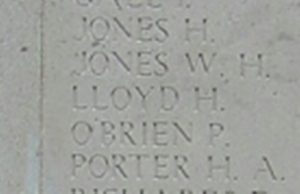
Norton Garland Lloyd, Private, 3513440, Manchester Regiment. Norton was the son of Vaughan William Lloyd and Ellen Lloyd, of The School House, Gaufron, Rhayader. He had enlisted into the army just before the Armistice, and instead of being demobilised, chose to remain in the forces, joining the Manchester Regiment. He was posted out to Mesopotamia, joining the 2nd Battalion, Manchester Regiment, which was on garrison duties in the country. The campaign in Mesopotamia had ended with the surrender of the Turkish forces at Mosul on 31 October 1918, and the British attempted to put an organised system of Government into place, to replace the former Turkish rulers. However, the Arabs soon started to organise themselves into armed groups, and a series of insurrections began, which resulted in many casualties on both sides. One such insurrection saw Norton lose his life. On 23 July 1920 Kifl station was attacked by insurgents and the railway staff were held captive, so the British sent a column, known as the Manchester Column, as a show of force. The column soon began to suffer from the extreme heat, and on the following day, 24 July 1920, the troops struck camp, to rest. Soon afterwards a force of around 3,000 insurgents attacked the camp and both sides opened fire. The column then began to retreat towards Hillah, a town just south of the Tower of Babel, and during the evening came under attack from mounted Arabs. Fierce fighting raged throughout an evening which saw many acts of gallantry performed by members of the column. Some men were taken prisoner by the Arabs, and later killed, while the column had suffered the loss of 20 men killed, 60 men wounded and 318 missing. Some of the missing were released afterwards, but it is believed that around 100 prisoners from the Manchester Regiment were taken to Najaf and killed there. Norton appears to have been killed during the fighting in the evening of 24 July 1920. The 18-year-old has no known grave and is commemorated on the Basra Memorial, Iraq. He was posthumously awarded the General Service Medal, with Iraq clasp.
Robert Evan Lewis-Lloyd, Lieutenant, Royal Navy. Robert was born at Taunton on 6 April 1895, the son of Robert Wharton Lewis-Lloyd and Elizabeth Alice Lewis-Lloyd (nee Williams). By 1901 the family was living at Elizabeth’s native Nantmel. He enlisted into the Royal Navy after leaving school and by the end of 1917 had been promoted to Lieutenant and was serving aboard the M-class destroyer HMS Opal. She had been commissioned in April 1916 and saw action during the Battle of Jutland whilst attached to the 12th Destroyer Flotilla, based at Scapa Flow as part of the Grand Fleet. On 12 January 1918, Opal joined her sister ship Narborough and the light cruiser Boadicea in a night patrol to hunt German warships off the Scottish coast. The weather was so bad that the ships were in danger of founding, so were ordered back to Scapa Flow, but whilst making their way back, both of the destroyers struck rocks and foundered in the heavy seas, causing the loss of all bar one single survivor. Robert was 22 years old when he died that day, and is commemorated on the Portsmouth Naval Memorial, Hampshire. He is also commemorated on the Nantmel War Memorial.
Thomas Frank Mason, Sergeant, 3/8677, Dorsetshire Regiment. Thomas, known as Frank, was born on 24 February 1887, the illegitimate son of Elizabeth Mason. He was raised by his grandmother, Mrs. Elizabeth Owen, of 3, Castle Road, Rhayader. He moved to South Wales prior to the war, to find work as a coalminer, and lodged at 9, High Street, Trelewis. Frank enlisted into the Royal Artillery at Merthyr on 2 September 1914, but was transferred to the Somerset Light Infantry, and entrained at Cardiff for Taunton. On 9 September Frank was transferred to the 3rd Battalion, Dorsetshire Regiment, and on 27 January 1915 was posted to France, joining the 1st Battalion, Dorsetshire Regiment, which was attached to 15 Brigade, 5th Division. He joined the battalion in billets at Dranoutre, just before it marched to billets at Bailleul. The Division was holding the line near Lindenhoek, in the Ypres Salient, and its infantry battalions were rotating in the front-line trenches. During March the Division moved slightly north to the Ypres defences, near St. Eloi. The Division saw heavy fighting during the Second Battle of Ypres, which was launched on 22 April 1915, following a German gas-attack at Gravenstafel, and raged until 25 May. On 30 April the 1st Dorset’s moved into the front line at Hill 60 and at 07.15 the following morning, the Germans launched a gas-attack against the Hill 60 trenches, following up with an infantry assault. Frank was among many casualties suffered by the battalion as a result of gas inhalation, and on 3 May 1915 he was admitted to the 14th Field Ambulance, before being sent to the 9th General Hospital at Rouen, and was transferred to England on 16 May for further treatment. Upon recovering, Frank was posted back out to France on 23 December 1915, joining the 6th Battalion, Dorsetshire Regiment, which was attached to 50 Brigade, 17th (Northern) Division. The division was in the southern area of the Ypres salient and saw heavy fighting at the Bluff during February 1916 before moving south, where they fought at the Battle of Albert, where the Division captured Fricourt at heavy cost during the opening of the Somme Offensive. On 25 July 1916 Frank was hospitalised, after contracting influenza, and spent a month in hospital before re-joining the battalion. During February and March 1917, he suffered from several bouts of sickness, and was diagnosed as suffering from impetigo, being sent back to England again. He re-joined the battalion on 4 July 1917, in time to take part in the Passchendaele offensive. The Division then moved to the Cambrai sector, and took over positions in the Flesquières Salient over the winter. Frank became ill again during the spring of 1918, and died of broncho-pneumonia at the 29th Casualty Clearing Station on 14 March 1918, aged 31. He was buried in Grevillers British Cemetery, Bapaume, France. Just two weeks later his battalion was hit by the Germans offensive, losing 300 men in four days of fighting.
John Harold Meredith, Private, 31552, King’s Shropshire Light Infantry. John, known as Harold, was the son of Edward Meredith and Rose Emily Meredith (nee Pearson), of Rhayader. His parents were living at Caerphilly prior to the war, where his father worked as a collier, but Harold remained in Rhayader, living with his grandfather at Penybont Station. He enlisted at Dolau into the King’s 4th Battalion, Training Reserve, at Kinmel Park, and was posted to France in 1917, joining the 1/4th Battalion, King’s Shropshire Light Infantry, which had recently arrived on the Western Front, following service in Hong Kong and Singapore. The battalion had joined 190 Brigade, 63rd (Royal Naval) Division at Ypres on 18 August 1917, and took part in the latter stages of the Third Battle of Ypres, during the capture of the Passchendaele Ridge. The Division then moved south to take part in the Battle of Cambrai, and saw heavy fighting at Welsh Ridge. On 4 February 1918 the 4th KSLI was in reserve at Beaulencourt, when it transferred to 56 Brigade, 19th (Western) Division, in the same sector. The 4th KSLI left Welsh Ridge and joined 56 Brigade at Rocquigny, before moving into billets at Bouzincourt, north of Albert, out of the line, for re-organisation. On 7 March the battalion moved back towards the front line, travelling by trams from Albert to Bapaume and moved to Hermies, ready to take over positions on the Metz Defences. On 21 March 1918 the Germans launched their massive Spring Offensive, Operation Michael, along the front line running from Croisilles to La Fère, and the 19th Division was moved forwards, to support the beleaguered front-line troops, many of which had been over-run. Just before midnight, the 4th KSLI moved into positions at Fremicourt, and 56 Brigade set up positions in support of 58 Brigade, around the village of Beugny, ordered to defend the village, so that the troops withdrawing from the front could retreat safely. The 4th KSLI proceeded to take up positions Lebucquière, and on 23 March came under attack by the Germans. The adjacent 25th Division was seen to be withdrawing, so the 4th KSLI was ordered to withdraw to the Fremicourt-Beugny Line. As the Germans advanced further, the 4th KSLI moved back to Bancourt and dug-in. The Allied line was being pushed back at a rapid pace by now, and by the following day, the 4th KSLI was back in Bapaume, before carrying on the withdrawal the following day, moving to Grevillers, Irles and Miraumont to Hébuterne. Harold was killed in action near Hébuterne on 26 March 1918, just two days before the battalion was relieved. The 19-year-old has no known grave and is commemorated on the Arras Memorial, France.
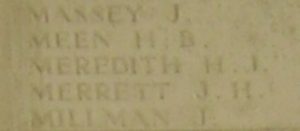
Benjamin Michael, Sapper, 67220, Royal Engineers. Benjamin was born at Nantmel in about 1890. He resided at Maesygelly, Nantmel prior to the war and worked as a carpenter. He enlisted at Rhayader into the Royal Engineers and was posted to the 126th Field Company, RE, which was attached to the 21st Division. He embarked for France with his unit on 12 September 1915, and the entire division assembled in the Loos sector. Fresh from England, the division was thrown into battle at Loos on 26 September, and suffered over 3,800 casualties for very little gain. The division moved to the Somme in 1916, and fought throughout the offensive. In March 1917 the division followed the German Retreat to the Hindenburg Line, and in April fought at Arras, during the First Battle of the Scarpe, the Third Battle of the Scarpe, and the Flanking Operations Round Bullecourt. Benjamin was killed in action here on 15 August 1917, just prior to the division leaving for Ypres. He was 27 years old and is buried in St. Leger British Cemetery, France. He is also commemorated on the Nantmel War Memorial.
William Thomas Middleton, Private, 19857, King’s Shropshire Light Infantry. William was the son of Philip and Elizabeth Middleton, of Vulcan Arms, Doldowlod, Rhayader. He enlisted at Knighton into the 7th Battalion, King’s Shropshire Light Infantry. The battalion was attached to 76 Brigade, 25th Division and landed at Boulogne on 28 September 1915, moving to the Ypres sector. 76 Brigade was then transferred to the 3rd Division at Ypres. William would have taken part in heavy fighting with the 7th KSLI during the Actions of the Bluff, and at the St Eloi Craters early in 1916, then during July 1916 the battalion moved south with the 3rd Division to the Somme sector. On 14 July the division took part in its first fighting on the Somme, during the Battle of Bazentin Ridge. Over the coming days the 7th KSLI suffered the loss of eight officers and 163n other ranks killed; seven officers and 294 other ranks wounded. The battalion had lost most of its original men, but William had, for now, survived. The remnants of the battalion moved into reserve to rebuild before moving back into the front by 18 August 1916, taking up positions south-east of Montauban. William was killed in action here that day, while the 7th KSLI was in support of an attack by the 10th RWF against Maltzhorn Farm. He was 24 years old and is buried in Guillemont Road Cemetery, Guillemont, France. William is also commemorated on the Nantmel War Memorial.
David Joseph Mills, Private, M2/174967, Royal Army Service Corps. David was the son of William and Hannah Mills, of Clewedog Cottage, Penybont Station. He worked as a gardener prior to enlisting at Llandrindod into the Army Service Corps and was posted to East Africa with the 648th Motor Transport Company, Army Service Corps. The British had a force in East Africa which had been built up to combat the guerrilla warfare employed by German led troops in the area. David became ill and died of disease in Tanzania on 19 November 1917, aged 32. He is buried in Dar Es Salaam War Cemetery, Tanzania. David is also commemorated on the Llandrindod Wells and Nantmel War Memorials.
Thomas Mills, Lance Corporal, 8209, Herefordshire Regiment. Thomas was born in Wigan in 1889, the son of Charles and Sarah Mills. His parents were from Machynlleth, and by 1901 had moved their family to Llandinam. Thomas lived with George and Mary Meredith at Victoria House, Rhayader for several years prior to the war, and worked as a Booking Clerk for the Cambrian Railways. He enlisted at Rhayader into the 1/1st Battalion, Herefordshire Regiment at some time prior to the outbreak of war. The battalion was a Territorial unit and mobilised at Hereford on 4 August 1914, attached to the Welsh Border Brigade, Welsh Division. The Division initially moved to its war station at Pembroke Dock, but soon moved via the Wellingborough area to Bury St. Edmunds, and then to Bedford, where the Division was numbered the 53rd (Welsh) Division. On 19 July 1915 the entire Division sailed from Devonport for Imbros and on 9 August 1915 landed at Suvla Bay. The infantry moved off the beaches into the bush, but due to a lack of maps and no knowledge of the terrain, many of the units became disorientated, and the situation became chaotic. Thomas was killed in action on 19 August 1915, aged 25. He is buried in Azmak Cemetery, Suvla, Gallipoli. Thomas is not commemorated on the Rhayader war memorial, but is commemorated on the Cambrian Railways Memorial at Oswestry.

Edward Pryce Morgan, Company Quartermaster Sergeant, 355031, Royal Welsh Fusiliers. Edward was born in Llangurig in 1872, the son of John and Mary Morgan. The family had moved to South Wales by 1891 and lived at Eglwysilan. Edward married Mary Lewis, at Sardis Chapel, Pontypridd on 21 November 1893, and by the couple were living in Elan Village, where Edward worked as a Butcher. By 1911 the family had moved to Whalley House, Rhayader, where Edward ran his own business and a Fellmonger and Roller Leather Manufacturer, assisted by the couple’s eldest son, Edward Pryce Morgan. Edward had enlisted into the 1st Battalion, Herefordshire Regiment (Territorials) on 7 January 1909, before transferring to the Montgomeryshire Yeomanry, and had attended the annual summer camp every year afterwards. By the time was erupted, he had been promoted to Sergeant, and once the Montgomery Yeomanry had been mobilised, moving to Norfolk with the South Wales Mounted Brigade, 1st Mounted Division, he was promoted to Staff Quartermaster Sergeant. The Division sailed from Devonport for Egypt on 4 March 1916, and was placed on the Suez Canal Defences. On 4 March 1917 the Montgomery Yeomanry was merged with the Welsh Horse Yeomanry to form the 25th (Montgomery & Welsh Horse Yeomanry) Battalion, Royal Welsh Fusiliers, in the newly formed 231 Brigade, 74th (Yeomanry) Division. The Division then took part in the Second Battle of Gaza, which resulted in a defeat by the Turks, before the EEF placed under the command of Sir Edmund Allenby, who reorganised his new command, before launching a third offensive against Gaza on a wider front, running from Gaza to Beersheba, on 1 November 1917. This time the EEF broke the Turkish lines, opening the way to Jerusalem, and captured the Holy City on 9 December. The EEF then continued its advance northwards over the coming months. Edward took ill, contracting malaria during the relentless advance northwards through the barren desert, and was initially sent to the Red Cross Hospital at Montazah, before being transferred to the 71st General Hospital at Helmand on 22 November 1917. Edward eventually weakened and died of enteritis on 14 February 1918, aged 46. He is buried in Cairo War Memorial Cemetery, Egypt.
George Morgan, Private, 8258, Herefordshire Regiment. George was born at Staylittle, Llanidloes, the son of John and Anne Morgan. He married Annie Louisa Jones in 1910, and the couple lived at Tycerrig Cottage, Rhayader, where their two children were born. George was a long serving Territorial, having enlisted into the 1st Battalion, Herefordshire Regiment prior to 1908. The battalion was a Territorial unit and mobilised at Hereford on 4 August 1914, attached to the Welsh Border Brigade, Welsh Division. The Division initially moved to its war station at Pembroke Dock, but soon moved via the Wellingborough area to Bury St. Edmunds, and then to Bedford, where the Division was numbered the 53rd (Welsh) Division. On 19 July 1915 the entire Division sailed from Devonport for Imbros and on 9 August 1915 landed at Suvla Bay. The infantry moved off the beaches into the bush, but due to a lack of maps and no knowledge of the terrain, many of the units became disorientated, and the situation became chaotic. George was wounded at some time after the landings, and was evacuated by Hospital Ship to the 21st General Hospital at Alexandria, where he died of his wounds on 21 August 1915, aged 26. He is buried in Alexandria (Chatby) Military & War Memorial Cemetery, Egypt.
Leonard Samuel Morgan, Private, 238945, Herefordshire Regiment. Leonard was the son of Samuel and Mary Morgan, of Mill House, Abbeycwmhir. He enlisted locally into the Herefordshire Regiment and was posted to the 1st Reserve Battalion, Herefordshire Regiment at Oswestry. Leonard became ill and died at Oswestry Hospital on 16 February 1917, aged 19. His remains were brought home for burial in St. Mary’s Churchyard, Abbeycwmhir. The inscription on his grave reads: ‘PEACE PERFECT PEACE’.
Edwin Thomas Morris, Private, 09370, Army Ordnance Corps. Edwin was born on 12 January 1893, the son of Evan and Lucy Morris, of Ty-Cerrig, Rhayader. He worked as an Ironmonger’s Assistant prior to the war. Edwin enlisted at Rhayader into the Army Ordnance Corps, and embarked for Egypt on 24 October 1915, joining Alexandria Company, AOC. The Army Ordnance Corps was the body charged with supplying weapons, ammunition and equipment to the British Army, so Edwin would probably have worked at a large depot in Alexandria, where a very large logistical supply base had been set up. Edwin took ill within weeks of arrival, and died of dysentery at No 15 General Hospital, Alexandria on 9 December 1915. The 22-year-old was buried in Alexandria (Chatby) Military & War Memorial Cemetery, Egypt. His brother, Evan Price Morris, was killed in 1918.
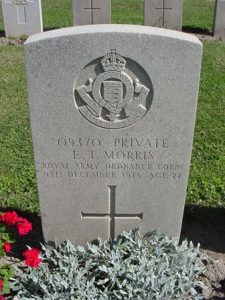
Evan Price Morris, Second Lieutenant, North Staffordshire Regiment. Evan was born on 14 June 1891, the son of Evan and Lucy Morris, of Ty-Cerrig, Rhayader. He worked as a Gardener prior to the war. Evan enlisted at Rhayader into the Army Ordnance Corps, but was then transferred to the North Staffordshire Regiment, embarking for France on 17 September 1915, and joined the 5th Battalion, North Staffordshire Regiment, which was attached to 137 Brigade, 46th (North Midland) Division. The Division had spent a very short time in Egypt before returning to France, and on 1 July 1916 took part in the attack on the Gommecourt Salient, which was a diversionary attack intended to draw attention away from the main attack on the Somme, but suffered large numbers of casualties during the attack. The Division rested for several months at Arras, and at the end of 1916 took part in Operations on the Ancre. During March 1917 the Division followed the German Retreat to the Hindenburg Line, and then fought in the Battle of Arras, taking part in the Battle of Hill 70. On 30 April 1918 Evan was commissioned as Second Lieutenant into the North Staffordshire Regiment, but was attached to the 12/13th Battalion, Northumberland Fusiliers, which was attached to 62 Brigade, 21st Division. The Division had suffered severe casualties during the three phases of the German Spring Offensive, and rebuilt in the summer before taking part in the great offensive from 21 August 1918. The Division advanced north of the River Ancre over the coming days, helping push the Germans back towards the Hindenburg Line. During the first week of October the Division had moved through Gonnelieu to Gouzeaucourt, and on 7 October took up assembly positions, in readiness for another advance the following morning. Evan’s battalion was situated behind Beaurevoir Trench, and at dawn the following morning, 8 October 1918, launched an assault on the village of Walincourt. Evan was killed in action during the attack that day. The 27-year-old is buried in Bois-Des-Angles British Cemetery, Crevecoeur-Sur-L’Escaut, France. His brother, Edwin, had died in Egypt in 1915.
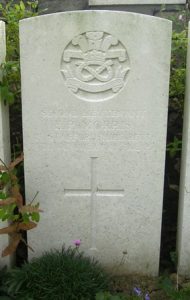
Thomas Davies Mytton, Private, 55484, Royal Welsh Fusiliers. Thomas was born at Knighton in 1892, the son of Richard and Alice Mytton. His father was from Abbeycwmhir and just after the turn of the century the family moved back to Cwmhir Cottage, Abbeycwmhir. Thomas worked as a waggoner at a farm at Clun prior to the war and was a Territorial soldier, having enlisted at Rhayader into the Montgomeryshire Yeomanry some years prior to the war. At sometime late in 1916, he was posted to France, joining the 17th Battalion, Royal Welsh Fusiliers, which was attached to the 38th (Welsh) Division. The division had just been withdrawn from the Somme sector after its mauling at Mametz Wood, and took up the canal bank line north of Ypres, near Boesinghe, where it remained for the next year before taking part in the opening assault of the Third Battle of Ypres, capturing Pilckem Ridge on 31 July 1917. After wintering in the Armentieres area, the division moved south to positions north of Albert, where it took up the line facing across the Ancre valley, facing Thiepval Ridge. Thomas was killed by artillery fire near Mesnil while attached to the 115th Trench Mortar Battery on 9 June 1918, aged 26. He is buried in Mesnil Communal Cemetery Extension, France.
Richard Harold Page, Private, 8226, Herefordshire Regiment. Richard was born on 10 August 1895, the son of John and Matilda Page of Rhayader. Following the death of his mother in 1904, Richard went to live with his grandparents, Richard and Eleanor Breeze, at Bryncoed, Llandrindod Wells, while his father moved to 42, Aberdare Road, Abercynon, where he worked as a Baker and Confectioner. Richard enlisted at Rhayader into the 1/1st Battalion, Herefordshire Regiment soon after the outbreak of war. The battalion mobilised for war at The Barracks, Hereford, as part of the Welsh Border Brigade, Welsh Division and moved to its war station at Pembroke Dock. On 10 August the battalion moved to Oswestry, before joining the Welsh Division at Bedford in May 1915. The Division was then numbered the 53rd (Welsh) Division. On 19 July 1915 the entire Division sailed from Devonport for Imbros and on 9 August 1915 landed at Suvla Bay. The infantry moved off the beaches into the bush, but due to a lack of maps and no knowledge of the terrain, many of the units became disorientated, and the situation became chaotic. The situation settled down over the coming days, but was still precarious, with the Division coming under almost constant artillery and sniper fire. Richard was killed by a sniper at Suvla on 19 August 1915, aged 19. He is buried in Azmak Cemetery, Suvla, Gallipoli. Richard was a very popular man in the battalion, known as the ‘Wag’ of his Company, who was reported to be always cheerful and smiling, his death was felt keenly by his comrades.
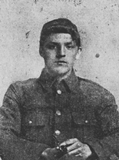
David Palmer, Private, 18468, South Wales Borderers. David was born in Burton-on-Trent in 1879, the son of Japhet Flatt and Fanny Flatt (nee Foyle). His mother died soon after his birth. For some reason, he left home as a young man, and came to Rhayader under the alias of David Palmer. David enlisted at Newport, Mon into the 3rd Battalion, South Wales Borderers soon after the outbreak of war, still under his alias. After completing his training, he embarked for France on 11 January 1915, joining the 1st Battalion, South Wales Borderers, which was attached to 3 Brigade, 1st Division. David joined the battalion at Givenchy, where it was enduring a trying time, working on trench repairs in pouring wet, muddy, conditions, interspersed with snow and frost. The battalion endured a long spell in the front line here until being relieved on 3 February and moved to billets in Lapugnoy. By April the Division had spent some time at Port Arthur before taking over the notorious Cuinchy sector, and on 9 May 1915 took part in the Battle of Aubers Ridge, attacking from positions at the Rue du Bois. The Division remained in the Flanders trenches over the coming months leading up to the Battle of Loos on 25 September. Just prior to this, the 1st SWB was holding the line in the Cambrin Sector, when David was wounded towards the end of August. He was evacuated to the 13th Stationary Hospital at Boulogne, where he died of his wounds on 2 September 1915, aged 36. David is buried in Boulogne Eastern Cemetery, France.
John William Perry, Private, 37206, Worcestershire Regiment. John was the son of David and Ann Perry, of 4, Elan Village, Rhayader. He had moved to Birmingham to work as an agricultural labourer, and married Harriett Amanda Tanswell in 1906, before the couple set up home at 191, Bromford Lane, Erdington. John enlisted at Birmingham into the Worcestershire Regiment, and after completing his training was drafted to France, joining the 1st Battalion, Worcestershire Regiment, which was attached to 24 Brigade, 8th Division. John probably joined the battalion over the winter of 1916-1917, when it was rebuilding following losses during the Somme offensive. The battalion wintered on the Somme, at No 16 Camp, on the Méaulte to Bray road and then moved to the Airaines area for training, before moving back to the Somme, taking over a section of front line at Bouchavesnes before following the German withdrawal to the Hindenburg Line. The Division launched an attack on Fritz Trench on 4 March 1917, capturing their objectives and beating off a counter-attack, and over the coming days advanced to Villers-Guislain and Gouzeaucourt. By 1 June the Division had moved out of the Hindenburg Line area to Corbie and entrained for the Ypres Salient, reaching Ypres by 14 June, and took over a section of line in the Hooge sector. The infantry battalions of the Division then began the usual routine of trench rotation, interspersed with spells out of the line training for the forthcoming offensive, the Third Battle of Ypres. During the night of 30 July, the 1st Worcester’s moved into position, ready to launch their assault on the following morning, marching past Birr Cross Roads, with orders to attack Ignorance Trench, Ignorance Reserve and James Trench, and to dig in and create a new line on the Bellewaarde Ridge. At dawn on 31 July 1917 the Third Battle of Ypres opened, and the battalion launched its attack against its objectives, bombing dugouts as it moved forwards behind a creeping artillery barrage. John was killed in action at some time during the day. The 35-year-old has no known grave and is commemorated on the Ypres (Menin Gate) Memorial, Belgium.
David Phillips, Private, 19903, South Wales Borderers. David was born at Upper Chapel, Breconshire, the son of Thomas Phillips and Sarah Phillips (nee Jones). He worked as a waggoner prior to the war. His father had died when he was young, and in 1913 his mother married John Oliver, a shepherd, of Gammallt, Rhayader. David enlisted at Newport into the 3rd Battalion, South Wales Borderers soon after the outbreak of war, and on 20 September 1915 embarked for Gallipoli, joining the 2nd Battalion, South Wales Borderers, which was attached to 87 Brigade, 29th Division. The Division had been on the Peninsula since the landings of 25 April, and remained there until evacuation to Egypt on 11 January 1916, before being transferred to the Western Front on 15 March 1916. The Division took over a section of front line near Beaumont Hamel, facing the German strongpoint of Y-Ravine, and its infantry battalions soon began the usual routine of trench rotation over the coming weeks. On 3 April 1916 the 2nd SWB moved into the Somme trenches for the first time and on the following day suffered a heavy bombardment by German trench mortars. The battalion sent out patrols on 5 April, to examine the wire in front, suffering two men missing. The battalion then came under heavy shellfire again during the afternoon. Another patrol was sent out on 6 April, to attempt to locate the missing men, but was unsuccessful, and when returning, the Germans opened up another heavy barrage onto the line held by the 2nd SWB before launching a large-scale trench raid at around 22.30. Heavy fighting raged throughout the night, while the Germans managed to withdraw, taking a number of prisoners with them. David had been wounded during the fighting that night, and died of his wounds on 7 April 1916, aged 23. He is buried in Gézaincourt Communal Cemetery Extension, France. David is not commemorated on the Rhayader war memorial, but on the Upper Chapel war memorial, Breconshire.
Frank Archibald Price, Private, 381535, The King’s Liverpool Regiment. Frank, known as Archibald, was born on 28 April 1892, the son of Rees and Cordelia Price, of 7, Rock Cottages, Rhayader. He married Daisy Winifred Lewis, a domestic servant from Kington, at Rhayader on 2 May 1914 and the couple set up home at Tower Cottage. Archibald enlisted into the Herefordshire Regiment at Hereford, and after completing his training, was posted to Gallipoli on 1 September 1915, joining the 1/1st Battalion, Herefordshire Regiment, which was attached to 158 Brigade, 53rd (Welsh) Division. The Division was eventually evacuated from Gallipoli in December 1915, moving to Egypt to join the EEF, and helped guard the Suez Canal before taking part in operations to drive the Turks out of the Sinai. Archibald then came home, having served his time with the Territorials, but re-enlisted into the army and was posted to France, joining the 13th Battalion, The King’s Liverpool Regiment, which was attached to 9 Brigade, 3rd Division. The Division saw heavy fighting on the Somme in the summer of 1916, and by May 1917 was at Arras, taking part in the First and Second Battles of the Scarpe, then at the Battle of Arleux and the Third Battle of the Scarpe, where it captured Roeux. The Division then moved to Ypres, taking part in the Third Battle of Ypres, and fought at the Battle of the Menin Road and the Battle of Polygon Wood. In November the Division moved south again, where they fought at the Battle of Cambrai, remaining in the area over the winter. The Division was hit hard when the Germans launched their Spring Offensive on 21 March 1918. The 13th Liverpool’s were in reserve at Shaft Trench, in the Hindenburg Tunnel when the Germans hit, and on the following day could see the Germans on the high ground near Croisilles. The situation was chaotic, with the British line broken, so the Liverpool’s were forced to withdraw towards Neuville-Vitasse over the coming days, alongside the Welsh Guards, before the depleted units managed to stem the German advance. After a short spell in reserve at Ivergny, the battered 3rd Division was then transferred to the quieter Lys sector to rebuild, taking over positions at Houchin, near Festubert. Unfortunately, the Germans launched the second phase of their offensive along the Lys Valley on 9 April 1918, and the Division was ordered forward to take up positions at Gorre Wood and Festubert Keep. At noon on 11 April 1918 the Germans hit the Division with an intense artillery barrage, before their infantry advanced, and heavy fighting raged, with both sides counter-attacking each other, and defensive positions changing hands throughout the day. Archibald was killed in action near Festubert on 11 April 1918. The 25-year-old has no known grave and is commemorated on the Loos Memorial, France.
John Edward Price, Private, 39644, Royal Welsh Fusiliers. John was the son of Edward and Dinah Price, of Upper Mill, Rhayader. He worked as a Grocer’s Assistant, and lived at 2, Talbot Road, Ammanford prior to the war. He enlisted there on 11 December 1915 into the Royal Welsh Fusiliers, being sent to the main recruitment centre at Carmarthen for his medical. John was posted to France on 30 December 1916, joining the 13th Battalion, Royal Welsh Fusiliers, which was attached to 113 Brigade, 38th (Welsh) Division. John joined the battalion on the Canal Bank, north of Ypres, where it had moved following its mauling during the capture of Mametz Wood in July 1916. He joined the ranks of the battalion on 1 January 1917, while it was in reserve at D Camp, near Poperinghe, carrying out intensive training. On 14 January the 13th RWF moved back into the line at Trois Tours, and over the coming months the infantry battalions of the 38th Division carried out the usual routine of trench rotation, interspersed with trench raids and supplying working parties. The division remained here for almost twelve months, before launching its famed assault on the Pilckem Ridge on 31 July 1917. The Division attained all of its objectives during the initial attack, before digging in and consolidating its new positions, with the 13th RWF HQ setting up at Telegraph House. The Division then suffered incessant shellfire throughout the night, and the 13th RWF suffered casualties whilst moving into positions on the Steenbeek during the evening. John was killed in action at Pilckem Ridge on 1 August 1918, while the division was consolidating its gains on the Steenbeek. He was 31 years old, and is commemorated on the Ypres (Menin Gate) Memorial, Belgium.
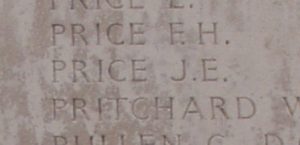
Thomas Reginald Price, Private, 2022, Montgomeryshire Yeomanry. Thomas, known as Reggie was the son of Richard and Harriet Price, of Ffynonfair, Rhayader. He worked as a Groom for Mrs Nicholls prior to the war. Reggie had enlisted into the 1st Battalion, Herefordshire Regiment (Territorials) at Rhayader on 24 May 1913, and was transferred to the Montgomeryshire Yeomanry. Reggie attended his first annual TA summer camp that year. On 5 August 1914 the Montgomeryshire Yeomanry was mobilised at Welshpool, as part of the South Wales Mounted Brigade, before moving via Hereford to Thetford, to join the 1st Mounted Division. Reggie served with D Squadron, under Major D. B. Parry, and had been recognised as being a very efficient soldier. Sadly, he took ill at Aylsham, and was sent home on 8 May to recuperate, but died of meningitis on 10 June 1915, aged 20. Reggie was buried with full military honours in Tabernacle Congregational Chapelyard, Rhayader. Major Parry wrote to his bereaved parents soon afterwards: ‘I am writing on behalf of myself, the officers and men of the Radnorshire Squadron, to offer you our sincere sympathy in the great loss you have sustained by the death of your son. He was very popular in the squadron with all ranks, and but for his health would have made a most efficient and useful soldier. We were all very sorry to lose him when he was discharged, and we were all deeply grieved when the news of his death reached us.’
Gerald Thornton Prickard, Second Lieutenant, South Wales Borderers. Gerald was born on 8 November 1884, the youngest of six sons of Reverend William Edward Prickard and Maria Georgiana Prickard (nee Morris), of Dderw, Rhayader. He was educated at Marlborough College from 1898 until 1902, then worked in the Shipping Industry in South Africa. Gerald was home visiting his family when war erupted, and volunteered his services to the army, being commissioned into the 3rd Battalion, South Wales Borderers on 8 November 1914. He was initially posted to the 2nd Battalion, South Wales Borderers, but was then attached to the 1st Battalion, Royal Dublin Fusiliers, which was in the same Division as his former battalion, the 29th Division. The Division had been formed from a hard-core of regular battalions which had been recalled to Britain following garrison duties around the Empire, and on 16 March 1915 sailed from Avonmouth for Alexandria. On 9 April the Division sailed for Mudros, and on 25 April 1915 landed under heavy fire at V Beach, Cape Helles, Gallipoli from the battleship HMS Cornwallis, suffering terrible casualties. The battalion suffered such losses, that on 30 April it was temporarily merged with the 1st Royal Munster Fusiliers, forming a composite battalion, and it was three weeks before it resumed its own identity. Gerald was killed in action whilst leading his platoon on an assault against the Turkish trenches on 4 June 1915. No trace of the 30-year-old was ever found, so he is commemorated on the Helles Memorial, Gallipoli. His eldest brother, Harry Seddon Prickard, had died of enteric fever at Bloemfontein during the Boer War.
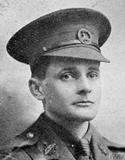
Samuel Charles Pritchard, Private, 25621, Grenadier Guards. Samuel was the son of William and Fortune Pritchard, of Hill House, Penybont Station. He worked as a postman prior to enlisting at Knighton into the Grenadier Guards and was posted to France in 1916, joining the 2nd Battalion, Grenadier Guards, which was attached to the 1st Guards Brigade, Guards Division. During July 1916 the Division moved from the Loos area to the Somme, and took part in the Battle of Flers-Courcelette, the first time that tanks were used in warfare. The division then took part in the Battle of Morval, capturing Lesbœufs Village. It remained here for the winter, which was particularly harsh. Samuel had taken ill during this time and died of pneumonia on 14 February 1917, aged 23. He is buried in Grove Town Cemetery, Méaulte, France. Samuel is also commemorated on the Nantmel War Memorial.
Percy Probert, Private, 11037, South Wales Borderers. Percy was born in Rhayader in 1894, the illegitimate son of Mary Probert, a Domestic Servant. He was adopted by Elizabeth Lewis, and raised at Gelligainfach, Nantmel, and worked as a farm labourer before enlisting into the South Wales Borderers on 25 April 1913. Percy joined the 1st Battalion, South Wales Borderers at Camp Bordon, and following the outbreak of war the battalion landed at Le Havre on 13 August 1914, attached to 3 Brigade, 1st Division. The division then moved to Landrecies by 25 August, some 25 miles south-west of Mons, where it dug in and met the retreating BEF. The 1st Division then joined the rest of the BEF in the great retreat south, reaching Soissons by 31 August, and then reaching the River Marne, enduring a harrowing time, constantly on the move and under constant fear of attack. The Allies then launched a counter-attack from the Marne on 6 September, and after fierce fighting drove the Germans back towards the River Aisne. The scenes the soldiers met were truly awful, with dead soldiers and animals strewn all over the battlefield. On 14 September 1914 the 1st SWB advanced under heavy shellfire to a ridge to the north of Bourg, fighting and driving back the Germans all through the day. Percy was killed in action by shellfire during this advance that day. The 20-year-old has no known grave and is commemorated on the La Ferté-sous-Jouarre Memorial, France. He is not commemorated on the Rhayader war memorial.
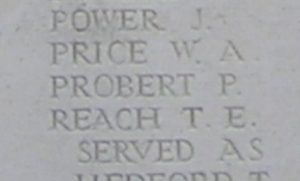
Edward William Rees, Guardsman, 3672, Welsh Guards. Edward was the son of James and Mary Rees, of Penpistyll, Nantmel. He enlisted into the Welsh Guards and was posted to France to join the 1st Battalion, Welsh Guards. The Regiment was raised by Royal Warrant of 26 February 1915, at White City, before landing at Le Havre on 18 August 1915, becoming attached to 3rd Guards Brigade, Guards Division. The Division saw its first major action during the Battle of Loos, which began on 25 September 1915, remaining in the area during the coming months, where they also fought in the subsequent Action of Hohenzollern Redoubt. In July 1916 the Division moved to the Somme, where it fought at the Battle of Flers-Courcelette, and then at the Battle of Morval, capturing Lesboeufs Village. The division remained here for the winter, and in March 1917 took part in the advance caused by the German Retreat to the Hindenburg Line. Later that year it moved north to Ypres and fought at the Battle of the Pilckem Ridge, the opening phase of the Passchendaele offensive. The Guards Division saw further fighting at Ypres, during the later stages of the offensive, before being moved south, taking part in the Battle of Cambrai and by the end of November was in the thick of the action. Edward was killed during an attack near Gouzeaucourt on 1 December 1917. Losses among the Welsh Guards were heavy during the days fighting. Edward was 19 years old and is commemorated on the Cambrai Memorial, Louverval, France. He is also commemorated on the Nantmel War Memorial. His brother, James, died of wounds just three months later.
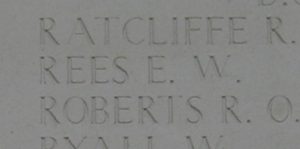
James Humphreys Rees, Gunner, 214958, Royal Field Artillery. James was the son of James and Mary Rees, of Penpistyll, Nantmel. He worked as a farm hand at Llawrllan Farm prior to enlisting at Knighton into the Royal Field Artillery and was posted ‘C’ Battery, 331st Brigade, RFA, which was attached to the 66th Division. The battery embarked for France with the division in March 1917, which moved to the Flanders Coast. At the end of September 1917, the division moved to Ypres, and took part in the Battle of Poelcapelle. It then moved south to the Somme, and on 21 March 1918 was hit by the German Spring Offensive, taking part in an epic rear-guard action over the coming days. James was seriously wounded during the first day of the offensive and was evacuated to the base hospital at Amiens where he died of his wounds on 24 March 1918, aged 21. He is buried in St. Pierre Cemetery, Amiens, France. He is also commemorated on the Nantmel War Memorial. His brother, Edward, was killed just three months previously.
Morgan Rees, Gunner, 190385, Royal Field Artillery. Morgan was the son of John Evan Rees and Anne Rees (nee Morris), of Tynshimley, Rhayader. He had worked as a Waggoner before being drafted into the Royal Field Artillery, and served on the Western Front throughout the war. Morgan’s health broke down as a result of his service, and he was diagnosed as suffering from phthisis before being discharged from the army. He died at Rhayader Hospital on 7 February 1921, aged 23 as a result of mania, brought on by his condition. He was buried in St. Bride’s Churchyard, Llansanffraid Cwmteuddwr. Morgan is not commemorated by the CWGC.
William Rees, Private, 1948, Welsh Guards. William was born on 11 October 1883, the son of Charles and Winifred Rees, of Castle Row, Rhayader. His parents later moved to 24, Exchange Road, Neath, whilst William moved to Llandybie, to work as a collier. He enlisted at Ammanford into the Welsh Guards in August 1915. The 1st Battalion, Welsh Guards had embarked for France on 18 August 1915, joining the newly formed 3rd Guards Brigade, Guards Division, and was thrown into action almost immediately, being sent into action during the Battle of Loos, which was opened on 25 September. The Welsh Guards suffered terrible casualties during their assault on Hill 70 on 27 September, and the battered Guards Division was then withdrawn to the Labourse area. The Guards then moved back to Vermelles, and saw further action at the Hohenzollern Redoubt during October before the Division moved to the Merville area, taking over the line near Laventie, and by the middle of February 1916 the Guards were moved to rest areas near Calais. William would have joined the 1st Battalion, Welsh Guards around this time, while the battalion was rebuilding. By 6 March the Guards had moved into the Ypres Salient, taking over the line at St. Jan ter Biezen and Potijze, and remained at Ypres until the end of July, when the Guards Division transferred to the Somme sector, to join the great offensive. On 9 September the Welsh Guards moved into the battle area, to Ginchy, and relieved the battered troops in the front line. Immediately the Welsh Guards came into contact with parties of Germans, and the situation became chaotic and desperate fighting raged over the coming days. William was killed in action here, at the Battle of Flers-Courcelette, on 16 September 1916, aged 33. He was originally buried in the battlefield near Ginchy, but in 1929 his grave was exhumed, and he was identified by items of personal kit with his service number, ‘W.G. 1948’, before his remains were re-interred in Serre Road Cemetery No. 2, France, the biggest cemetery on the Somme.
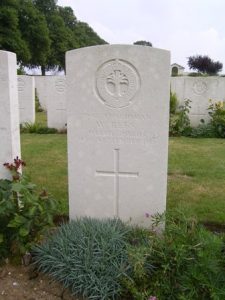
William Mervyn Montague Vere Coren Richardson, Gunner, 318917, Canadian Field Artillery. William was born at Bryncoed, Rhayader on 13 January 1893, the son of Dr Frank Lewis Charles Richardson and Emily Margaret Richardson (nee Cosens). His parents divorced in 1904, and his mother was given custody of the children. William was educated at Maidenhead before emigrating to Canada just before the outbreak of war, and found work as a Clerk in Vancouver. He enlisted into the Canadian Expeditionary force at Kingston, Ontario on 17 March 1916 and was posted to the 50th (Queen’s Battery), Canadian Field Artillery. He embarked for England on 27 April 1916 and after disembarking in Liverpool, entrained for the Canadian Camp at Shorncliffe. On 10 November 1916 William embarked for France, and was posted to the 2nd Canadian Division Ammunition Column, Canadian Field Artillery. In January 1917 he became ill, and was hospitalised for several weeks suffering from bronchitis. He returned to duty at the end of the month, by which time the 2nd Canadian Division was in the Arras sector, at Gauchin-Légal, north-west of Mont-St-Eloi. The weather was terrible, cold, wet and windy, making conditions arduous for the men and their transport horses. On 25 March 1917 the 2nd Canadian Divisional Artillery moved into battle positions. William was killed in action during the move that day. The 24-year-old is buried in Écoivres Military Cemetery, Mont-St. Eloi, France.
William Scott, Private, 242315, Queen’s Own (Royal West Kent Regiment). William was the son of Andrew and Sarah Scott, of Grove Cottage, Cwmdauddwr, Rhayader. He worked as a Shepherd prior to the war, and was a member of the Herefordshire Regiment (Territorials). Following the outbreak of war, William was mobilised, but instead of staying with the Herefords, was transferred to the 11th Battalion, Queen’s Own (Royal West Kent Regiment), which was attached to 122 Brigade, 41st Division. The battalion landed in France on 3 May 1916, and the entire Division moved to the Ploegsteert sector for trench initiation. It remained here until August 1916, when it was transferred to the Somme, and took part in the Battle of Flers-Courcelette. The Division remained in the line, pushing on to Courcelette over the next few days before coming out for a rest and re-fit. It then fought at the Battle of Le Transloy, before moving to positions south of Ypres, near Voormezeele, in October 1916. Here the Division wintered in the St. Eloi sector, before taking part in the Battle of Messines in June 1917. By the end of July, the Division had moved slightly north to the Spoil Bank sector, and on 31 July 1917, the opening day of the Third Battle of Ypres, attacked Hollebeke, the 11th Queens alone suffering over 300 casualties during the day. Two weeks later the 11th Queens moved into reserve, and did not return to the front until 17 September, when the battalion marched to Ridge Wood, and on 19 July the Division launched an assault on Tower Hamlets. William was wounded during the assault on Tower Hamlets, and died of his wounds on 23 September 1917, aged 23. He is buried in Larch Wood (Railway Cutting) Cemetery, Belgium.
William Thomas Stonebridge, Private, 55657, Royal Welsh Fusiliers. William was the son of Arthur Stonebridge and Lucy Stonebridge (nee Picken), of Brynawel, Castle Road, Rhayader. He had worked as a Grocers Apprentice prior to the war. William enlisted into the South Wales Borderers soon after the outbreak of war, but after completing his training was transferred to the Royal Welsh Fusiliers. He was posted to France early in 1917, joining the 10th Battalion, Royal Welsh Fusiliers, which was attached to 76 Brigade, 3rd Division. The Division had seen heavy fighting on the Somme, and the 10th RWF had gained two Victoria Crosses during the fighting in Delville Wood, before wintering on the Somme. In May 1917 the Division was at Arras, and fought at the First and Second Battles of the Scarpe, and at the Battle of Arleux and the Third Battle of the Scarpe, where it captured Roeux. William was wounded at Arras, being shot in the throat, and was eventually evacuated to Lincoln Hospital for treatment. Upon recovering he returned to France, initially joining the 19th Battalion, Royal Welsh Fusiliers, which was attached to 119 Brigade, 40th (Bantam) Division, but was soon wounded again. He was then posted to the 9th Battalion, Royal Welsh Fusiliers, which was attached to 58 Brigade, 19th (Western) Division, and probably joined the battalion early in 1918, while the 19th Division was holding a section of the line near Hermies. On 21 March 1918 the Germans launched the first phase of their Spring offensive here, on the front running from Croisilles to La Fère, and the 19th Division got caught up in desperate fighting over the coming days, especially during the desperate defence of Beugny, before being forced to withdraw to Hébuterne. The battered division was then transferred north, to the Messines sector, to rest and rebuild, but the Germans launched the second phase of their offensive along the Lys Valley on 9 April, and the Division once again became embroiled in desperate fighting near Oostaverne. The Division was relieved at the end of April and moved to Abeele, before taking over positions near Ridge Wood for a short while. William was killed in action here on 8 May 1918, near a position known as Ironbridge. The 21-year-old has no known grave and is commemorated on the Tyne Cot Memorial, Belgium. His father had also served during the war, becoming promoted to Regimental Sergeant Major before being discharged.
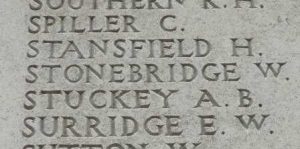
Edward Swan, Driver, 293457, Royal Horse Artillery. Edward was the son of Thomas and Sarah Maria Swan, of Elan Village, Rhayader. His father was a Civil Engineer for the Birmingham Corporation Water Department. Edward had enlisted into the Royal Field Artillery (Territorial Force) soon after the outbreak of war, and had served overseas for at least two years before being discharged as medically unfit. He re-enlisted into the Royal Field Artillery on 31 July 1919, but his health had by now broken down. Edward was discharged from the army on 24 October 1919, after being diagnosed as suffering from malaria, but his pension cards also noted that he had tubercle of hip and that he was suffering from mental instability as a result of his service. Edward eventually died at Neath on 2 February 1922, aged 23, plainly as a result of his service during the war. Edward is not commemorated by the CWGC, nor is he commemorated on the Rhayader war memorial.
David Thomas. David cannot presently be identified.
Leonard James Thomas, Private, 2438, Welsh Guards. Leonard was the son of Thomas and Lizzie Thomas, of Tycraig, Rhayader. He worked as a Telegraph Messenger prior to the war. Leonard enlisted into the Welsh Guards during 1915 and was posted to France early in 1916, joining the 1st Battalion, Welsh Guards. The Regiment had been raised by Royal Warrant of 26 February 1915, at White City, before landing at Le Havre on 18 August 1915, becoming attached to 3rd Guards Brigade, Guards Division. The Division saw its first major action during the Battle of Loos, which began on 25 September 1915, remaining in the area during the coming months, where they also fought in the subsequent Action of Hohenzollern Redoubt. In July 1916 the Division moved to the Somme, where it fought at the Battle of Flers-Courcelette, and then at the Battle of Morval, capturing Lesboeufs Village. The division remained here for the winter, and in March 1917 took part in the advance caused by the German Retreat to the Hindenburg Line. Around this time Leonard was evacuated to the Infantry Base Depot to recover from the effects of gas poisoning which, he wrote home, affected his memory for a while. He soon returned to duty, in time for the Divisions move to Ypres and fought at the Battle of the Pilckem Ridge, the opening phase of the Passchendaele offensive. The Guards Division saw further fighting at Ypres, during the later stages of the offensive, before being moved south, taking part in the Battle of Cambrai and by the end of November was in the thick of the action. The Division wintered on the Cambrai front, around Fampoux, and on 21 March 1918 was thrown into action when the Germans launched the opening phase of their Spring offensive, along the section of front running from Croisilles to La Fère. The Welsh Guards were in reserve when the offensive begun and moved into positions at Boisleux-St. Marc on 24 March. On the following day the battalion became caught up in heavy fighting when the Germans hit them in the line at Boyelles. The situation became so desperate that the Welsh Guards were forced to withdraw throughout the day. Leonard was wounded at some time during this period of ferocious fighting, and evacuated to a hospital at Étaples, where he died of his wounds on 30 March 1918, aged 21. He is buried in Étaples Military Cemetery, France.
Herbert Thomason, Private, 32077, Gloucestershire Regiment. Herbert was born in Weston-under-Redcastle, Shropshire in 1894, and was raised by his grandparents, Henry and Jane Thomason, at Weston Smithy, Weston, Hawkstone Park. He came to Rhayader to work as a cowman prior to the war. Herbert enlisted at Rhayader into the Herefordshire Regiment, and was posted to Northampton, where he met Katherine Agnes Roseblade. Herbert was posted to France before the couple had a chance to marry, and joined the 14th Battalion, Gloucestershire Regiment, which was attached to 105 Brigade, 35th Division. The battalion landed at Le Havre on 30 January 1916, and moved to billets in Ebblinghem before the division moved into the Festubert sector. The Division moved to the Somme early in July 1916 and saw its first major action during the Battle of the Somme during fighting at Trônes Wood. In September the Division was moved to the Arras sector, but by December 1916, the Divisional commander (Major-General Landon) reported that the Division was now suffering from low physical and morale standards, so the Division was pulled out of the line and reinforced, before carrying out a system of intensive training, before going back into the line in the Lihons Sector, and followed the German Retreat to the Hindenburg Line in March 1917. The 14th Gloucester’s were at work, filling in craters on the Nesle to Ham railway by the beginning of April, before taking over a section of front line by Gricourt on 16 April 1917, beginning a routine tour in the trenches, whilst also supplying working parties. Herbert was killed in action here, probably during one of the regular artillery bombardments suffered by the battalion, on 24 April 1917, aged 23. He is buried in Chapelle British Cemetery, Holnon, France. He is also commemorated on the Weston-under-Redcastle war memorial.
William Thomas Arnold Thompson, Private, 203678, Gloucestershire Regiment. William was the son of John and Harriet Thompson, of Bryn Villa, Rhayader. His father was the Registrar and Overseer for the district. William enlisted into the 1/5th Battalion, Gloucestershire Regiment at Rhayader. The battalion was attached to 145 Brigade, 48th (South Midland) Division and William probably joined the battalion following heavy losses during the Somme offensive in the summer of 1916. In March 1917 the Division followed the German Retreat to the Hindenburg Line, and later in the year fought at Third Ypres, taking part in several major engagements, during the Battle of Langemarck, the Battle of the Polygon Wood, the Battle of Broodeseinde and the Battle of Poelcapelle. The Division was ordered to Italy on 21 November 1917, where it would remain for the duration of the war. William probably did not embark for Italy, having taken ill at some time, and was invalided home. He died at Rhayader on 27 January 1918, aged 21, and was buried in St. Bride’s Churchyard, Llansantffraid-Cwmdauddwr.
David Rees Walters, Private, 42141, South Wales Borderers. David was the son of Thomas and Alice Walters, of Water Lane, Rhayader. He enlisted at Rhayader into the Herefordshire Regiment, and upon completing his training, was drafted to France in the summer of 1916, joining the 11th Battalion, South Wales Borderers, which was attached to 115 Brigade, 38th (Welsh) Division. The Division had taken part in the famous assault on Mametz Wood in July 1916. After two days of ferocious hand-to-hand fighting, the wood was cleared up to its northern edge, before the battered Division was relieved. It then took over a section of the front at Hébuterne before moving to the Ypres Salient, and taking over the Canal Bank sector at Boesinghe. The infantry battalions of the Division then began carrying out the normal pattern of rotation in the trenches, four days in the front, four in support and four in reserve, whilst also working on trench improvement, digging new trenches, and also carrying out regular patrols and trench raids. The Division was preparing to launch an offensive on the Pilckem Ridge, and during the summer, its infantry battalions spent time out of the line training and preparing for the great battle to come. On 14 June 1917 the 11th SWB moved into a tented camp at Proven and began training, then moved to Westrehem to train in replica practice trenches. By 19 July the 11th SWB was back at Proven, and by 30 July was back in position on the Canal Bank, where the Division was ready to go. At dawn on 31 July 1917 the Division launched its assault on the Pilckem Ridge, taking its objectives and reaching the Steenbeek before digging in. German resistance was severe, with machine-gun and rifle fire causing many casualties during the day. David was wounded at some time during the day, and was evacuated to the 61st Casualty Clearing Station at Dozinghem, where he died of his wounds on 3 August 1917, aged 25. David is buried in Dozinghem Military Cemetery, Ypres.
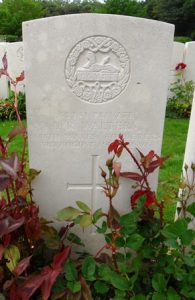
Maurice Edwin Weaver, Private, 8197, Herefordshire Regiment. Maurice was the son of Edwin Weaver and Mary Jane Weaver (nee Heath), of Welshpool. His father died just after his birth, so the family went to live with his fathers parents at Welshpool. He worked as a Hotel Porter at Rhayader prior to the war, and lodged with John and Mary Evans at Caeherbert Lane. Maurice had enlisted into the Herefordshire Regiment at Rhayader on 11 February 1911 and had attended every annual TA summer camp over the coming years. The battalion was a Territorial unit and mobilised at Hereford on 4 August 1914, attached to the Welsh Border Brigade, Welsh Division. The Division initially moved to its war station at Pembroke Dock, but soon moved via the Wellingborough area to Bury St. Edmunds, and then to Bedford, where the Division was numbered the 53rd (Welsh) Division. Maurice did not embark for Gallipoli with the Division as he was beginning to suffer from poor health and was posted to the 2/1st Battalion, Herefordshire Regiment, which was at Northampton attached to 205 Brigade, 68th (2nd Welsh) Division. He was taken to the 1st Southern General Hospital at Birmingham for treatment, but was found to have contracted pulmonary tuberculosis and was discharged from the army as medically unfit on 19 March 1916. Seriously ill, Maurice was taken to Newport Sanatorium, where he died of tuberculosis on 31 May 1916. The remains of the 25-year-old were brought home and he was buried in Christ Church Churchyard, Welshpool on 3 June.
William Edward Webb, Private, 236113, Herefordshire Regiment. William was the son of Evan and Elizabeth Webb, of Church Cottage, Cwmdauddwr, Rhayader. He worked as a Shop Assistant prior to the war. William enlisted at Rhayader into the 1st Battalion, Herefordshire Regiment. He did not embark for Gallipoli with the battalion in 1915, so must have been drafted out to Egypt in 1916, where the 1/1st Battalion, Herefordshire Regiment was attached to 158 Brigade, 53rd (Welsh) Division. The Division had been evacuated there from Gallipoli in December 1915, and helped guard the Suez Canal before taking part in operations to drive the Turks out of the Sinai. The EEF then turned its attention onto driving the Turks out of Palestine, and on 26 March 1917 launched its first offensive against the coastal city of Gaza, which guarded the road to Jerusalem. Initial gains during the day were lost when the assaulting divisions lost touch with each other and communication broke down when a thick fog cloaked the battlefield. A second attempt to force Gaza was launched on 17 April, which also failed, and the EEF suffered a change in leadership, with Sir Edmund Allenby assuming command, before being re-organised, and a third offensive was launched against a wider front from Beersheba to Gaza on 31 October 1917. This time the Turkish defences were breached, and the road to Jerusalem now lay open and the EEF began to advance north. On 6 November 1917, 158 Brigade launched an attack on the Khuweilfeh Heights, and once secured, the EEF continued its advance into the Judean Hills, the 53rd Division capturing Hebron and Bethlehem, before securing the Jerusalem to Jericho road. Allenby finally made his triumphant entry into Jerusalem on 11 December. On 1 June 1918 the 1st Herefords left the 53rd Division for France, entraining at Marseilles for Flanders, before joining 102 Brigade, 34th Division in the Ypres Salient. The battalion was in camp at Proven when the Allies launched their great offensive along the Western Front on 21 August 1918, then moved into the Kemmel area, at the Scherpenberg, on 1 September, ready to take part in the advance in Flanders. Their advance began on 4 September, following a creeping artillery barrage, but was initially held, due to impenetrable barbed wire. The battalion went back into reserve for several days before re-joining the offensive on 15 September and over the coming weeks advanced past Wytschaete towards Menin, reaching the canal at Halluin by 15 October. The battalion then had a rest before taking over the front line again on 23 October and on the following day, 24 October 1918, launched an assault to capture the canal crossings at Moen. William was killed in action during the fighting that day. The 24-year-old is buried in Harlebeke New British Cemetery, Belgium.
Gwilym Whitcombe, Private, 236087, Herefordshire Regiment. Gwilym was the son of George and Mary Whitcombe, of Cefnfaes, Rhayader. He worked as a Gardener prior to the war. Gwilym enlisted at Llandrindod Wells into the 1/1st Battalion, Herefordshire Regiment in February 1915. The battalion was a Territorial unit and mobilised at Hereford on 4 August 1914, attached to the Welsh Border Brigade, Welsh Division. The Division initially moved to its war station at Pembroke Dock, but soon moved via the Wellingborough area to Bury St. Edmunds, and then to Bedford, where the Division was numbered the 53rd (Welsh) Division. On 19 July 1915 the entire Division sailed from Devonport for Imbros and on 9 August 1915 landed at Suvla Bay. The infantry moved off the beaches into the bush, but due to a lack of maps and no knowledge of the terrain, many of the units became disorientated, and the situation became chaotic. The Division was eventually evacuated from Gallipoli in December 1915, moving to Egypt to join the EEF, and helped guard the Suez Canal before taking part in operations to drive the Turks out of the Sinai. The EEF then turned its attention onto driving the Turks out of Palestine, and on 26 March 1917 launched its first offensive against the coastal city of Gaza, which guarded the road to Jerusalem. Initial gains during the day were lost when the assaulting divisions lost touch with each other and communication broke down when a thick fog cloaked the battlefield. A second attempt to force Gaza was launched on 17 April, which also failed, and the EEF suffered a change in leadership, with Sir Edmund Allenby assuming command, before being re-organised, and a third offensive was launched against a wider front from Beersheba to Gaza on 31 October 1917. This time the Turkish defences were breached, and the road to Jerusalem now lay open and the EEF began to advance north. On 6 November 1917, 158 Brigade launched an attack on the Khuweilfeh Heights. Gwilym was killed in action during the assault that day. The 25-year-old is buried in Beersheba War cemetery, Israel.
Hugh Powell Evan Tudor Williams, Captain, Royal Navy. Hugh was born in Royton, near Oswestry, on 20 July 1874, the son of Colonel Hugh Powell Williams and Rosalie Ellen Williams (nee Norton), of Rhayader. He had enlisted into the Royal Navy on 15 January 1888 and was initially posted aboard HMS Britannia, then spent time aboard HMS Duke of Wellington and HMS Warspite before being promoted Midshipman on 15 May 1890. He then had several postings, including a time on experimental work, before being granted the Royal Humane Society’s Bronze Medal and Certificate for saving live on 1 August 1895, and was promoted to the rank of Sub-Lieutenant on 14 February 1896. He was a highly regarded officer, and specialised in Naval Gunnery, and over the coming years received several other postings before being promoted to the rank of Commander aboard HMS Bulwark on 30 June 1906. On 4 April 1908 he married Phyllis Margaret Mayo Robson, in London, and the couple set up their home at Moulsford Cottage, Moulsford, Berkshire. Hugh returned to sea, and was promoted to the rank of Captain on 31 December 1913 after continuing to impress his senior officers, and was sent to Queenstown, Ireland after having been given command of the Edgar-class protected cruiser HMS Hawke on 1 August 1914. On the outbreak of war Hawke, together with other ships of her class in Queenstown, formed the 10th Cruiser Squadron, and set to work operating on blockade duties between the Shetland Islands and Norway. Two months later the Squadron was deployed to the North Sea, to prevent German warships from attacking convoys bringing troops to Britain from Canada. On 15 October 1914, Hawke was on patrol with the Squadron off Aberdeen, when she was torpedoed by the German submarine U-9 and capsized. Hugh and 523 of his men died in the sinking. He was 40-years-old when he died that day, and is commemorated on the Chatham Naval Memorial, Kent.
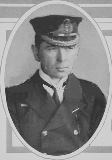
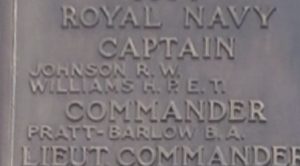
John Williams, Driver, 220511, Royal Field Artillery. John was the son of Robert and Ann Williams. His father worked for the Great Western Railway, and the family had lived in several places around Wales prior to becoming Station Master at Newbridge-on-Wye by 1911. John married Priscilla May Davies, of Cwm Defaid, Pant-y-Dwr, Rhayader, in 1916, after having enlisted at Knighton into the Royal Field Artillery. He was then posted to France, joining the Guards Division Ammunition Column. John probably saw his first action when the Guards Division moved to the Somme in the summer of 1916. After being moved from the Somme sector, the Guards Division enjoyed a relatively peaceful few months, until moving to the Ypres Salient to prepare for its assault on the Pilckem Ridge, as part of the opening of the Third Battle of Ypres, on 31 July 1917. John was accidentally killed at Ypres on 18 August 1917. The 24-year-old was buried in Canada Farm Cemetery, Belgium.
John E. Williams. John cannot presently be identified, but a Thomas Edward Williams, of Bridge End Buildings, Rhayader, served in WW1 and died of tuberculosis in 1922:
Thomas Edward Williams, Private, 82427, South Wales Borderers. Thomas was the son of Thomas Edward Williams and Margaret Ann Williams, of Bridge End House, Rhayader. He worked as a timber sawyer prior to the war. Thomas enlisted into the 53rd (Young Soldiers) Battalion, South Wales Borderers on 12 February 1918 and had served for over a year before being discharged, and re-enlisted again at Knighton on 17 February 1919. He was posted to Brecon, to join the 2nd Battalion, South Wales Borderers, but was sent to India to join the 1st Battalion, South Wales Borderers on 21 October 1919. After a year on garrison duty in India, his health broke down, and Thomas sailed home, disembarking on 7 November 1920. He was hospitalised at the Victorian Hospital, Netley where he was diagnosed as suffering from tuberculosis, and was discharged from the army as medically unfit on 30 November 1920. Thomas returned to Rhayader, but his health continued to fail, and he died of tuberculosis in 1922, aged 22. He was buried in Tabernacle United Reform Chapelyard, Rhayader. Thomas is not commemorated by the CWGC.
Abraham Davies Wozencraft, Private, 424258, Canadian Infantry. Abraham was born on 22 May 1880, the son of William and Jane Wozencraft, of Abbeycwmhir. He was a farmer who emigrated to Canada in 1905, where he set up his own farm. Abraham enlisted at Portage la Prairie on 4 March 1915 into the 45th Overseas Battalion, Canadian Infantry and embarked with the battalion aboard the SS Missanabie for England in February 1916. He arrived at Le Havre on 2 March 1916 and was drafted to the 28th (North West) Battalion, Canadian Infantry, which was attached to the 2nd Canadian Division. Abraham’s first major action came when the 2nd Canadian Division took over the line at the hotly contested St. Eloi craters on the night of 3 April and two days later were hit by a German attack, and saw heavy fighting in the heavily cratered ground. The 28th Battalion counter-attacked in conjunction with two other battalions on the following day but failed to regain any of the lost craters before being withdrawn. The fighting continued over the coming weeks while the Germans contemplated their next move. The Canadians held the high ground at Mount Sorrel, Hill 62 and Hill 60, and on the morning of 2 June 1916 launched a fierce attack, under cover of an artillery barrage, upon the Canadians. A counter-attack on the following day failed, and three days later the Germans struck another blow and exploded four mines under the Canadian lines, before capturing the remains of Hooge. Abraham was posted as missing during that terrible day, on 6 June 1916. He was later officially deemed as having been killed in action on that date. He was 36 years old and is commemorated on the Menin Gate Memorial, Ypres.
————————————————————————————————————————————————
World War Two, 1939-1945
David Bridges Billingham, Fusilier, 4189230, Royal Welch Fusiliers. David was born in Bromyard, Herefordshire in 1909, the son of David Billingham and Harriet Billingham (nee Metcalf). The family had moved to Tan House, Rhayader prior to the war. David married Emma Frances Morris, of Rhayader, in 1939. David had served with the 2nd Battalion, Royal Welch Fusiliers during the war. The battalion suffered heavy losses during the withdrawal to Dunkirk across Northern France in 1940, before the survivors were evacuated to England. The battalion was then rebuilt before embarking for the Far East, for service in Burma and India. David survived the war, but died at Rhayader on 20 June 1946, aged 37. He is buried in St. Clement’s Churchyard, Rhayader.
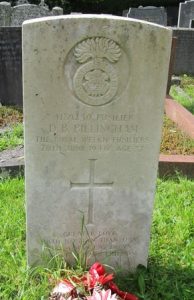
Arthur Corfield Somerset Clive-Davies, Sergeant, 1332179, Royal Air Force Volunteer Reserve. Arthur was the son of Colonel Arthur Lionel Clive-Davies and Audrey Veronica Clive-Davies, of Nantmel. He enlisted into the Royal Air Force Volunteer Reserve and after training was posted to 201 Squadron, RAF. The squadron had originally formed as No 1 Squadron, RNAS in 1914 and following the creation of the RAF in 1918 was renumbered 201 Squadron. It was flying the Saro London and Supermarine Stranraer at the outbreak of war, but soon re-equipped with the Short Sunderland, tasked with convoy escort and anti-submarine duties. On 1 August 1942, Arthur was flying aboard Sunderland III, Serial W4000, which had been despatched to escort the ships assembling to form convoy WS21 in the Clyde, when the Sunderland was brought down by friendly anti-aircraft fire in poor visibility, and crashed into the sea. Only one man survived, the remainder of the crew, eleven men, including Arthur, were killed. Arthur was 21-years-old when he died that day and is commemorated on the Runnymede Memorial, Surrey.
Mervyn Davies, Private, 14574334, The Queen’s Royal Regiment (West Surrey). Mervyn was the son of Evan James Davies and Blodwen Davies, of Abercamlo Farm, Llandewy Ystradenny. He enlisted into the army and was posted to the 1st Battalion, The Queen’s Royal Regiment. The battalion was in India at the start of the Second World War and fought for a year against Afghan tribesmen on the North-West Frontier. The Battalion then transferred to Burma to the 7th Indian Division and saw heavy fighting against the Japanese in the Arakan, at Kohima and in the final phase of the war, during the crossing of the Irrawaddy. Mervyn was killed in Burma on 14 June 1945, aged 20. He is buried in Rangoon War Cemetery, Myanmar. The inscription on the base of his headstone reads: ‘LOVED AND REMEMBERED ALWAYS. MOTHER, BROTHERS AND SISTERS’.
David Evans, Driver, T/291622, Royal Army Service Corps. David was born in Rhayader on 29 July 1908, the son of John and Mary Ann Evans. He married Beatrice Sarah Williams at Rhayader on 19 October 1932, and at some time afterwards, the couple moved to 25, Barbara Road, Hall Green, Birmingham. Little else is known of David, but he died at the Emergency Hospital, Winwick, Lancashire on 25 September 1943, aged 35. His remains were brought home for burial in Solihull Cemetery, Birmingham.
Martin Ricardo Gibson-Watt, DSC, Lieutenant, Royal Navy. Martin was born in Stroud in 1920, the son of Major James Miller Gibson-Watt and Marjorie Gibson-Watt (née Ricard). His father, from Nantmel and a descendant of the Scottish engineer James Watt, had served with the South Wales Borderers during the Great War, while his mother was the daughter of Henry and Adela Ricardo, of Gatcombe Park, and the couple moved to the Watt family home at Doldowlod, Llanyre after their marriage. Martin joined the Royal Navy prior to the war and passed as a Midshipman on 1 January 1938. His first wartime posting was as a Sub-Lieutenant aboard the D-class destroyer HMS Dainty. The destroyer took part in the Mediterranean convoys and had towed the disabled tanker Desmoulea to Suda Bay after it had been torpedoed by an Italian torpedo boat off Crete on 31 January. Dainty then returned to patrol the North African coast and on the afternoon of 24 February 1941 she had just left Tobruk with HMS Hasty when the ships were attacked by German Ju-88 bombers and Hasty was set ablaze, before sinking. Martin gained the award of the Distinguished Service Cross for his actions during the sinking of his ship. He was then promoted to Lieutenant and posted aboard the K-class destroyer HMS Kandahar. On 19 December 1941, Kandahar was part of British Force K, tasked to intercept an Italian convoy bound for Tripoli when she struck a newly laid Italian mine whilst attempting to rescue the stricken cruiser Neptune. Martin was one of 73 men killed in the explosion. The stricken Kandahar was scuttled the following day. Martin was just 21-years-old when he was killed on 19 December 1941 and is commemorated on the Plymouth Naval Memorial, Devon.
Edward Ingram, Guardsman, 2736377, Welsh Guards. Edward was born on 14 June 1915, the son of Thomas and Ada Ingram, of Nantmel. He married Sylvia Alice Davies in 1941. Edward worked as a gardener prior to enlisting into the Welsh Guards and was posted to the 2nd Battalion, Welsh Guards. The battalion had been formed on 18 May 1939 and embarked for France on 21 May 1940 to cover the withdrawal from Boulogne and formed a perimeter around the docks where it was attacked that same night by German infantry supported with Panzers. The battalion lost over 450 men during heavy fighting in Boulogne and rebuilt in the Codford area. Edward died during this period, on 25 August 1941, aged 26. His remains were brought home and he was buried in St. Cynllo’s Churchyard, Nantmel. His widow, Sylvia, later resided at Cwmfelinfach, Monmouthshire. The inscription at the base of Edward’s grave reads: “DEARER STILL AS YEARS DEPART HIS MEMORY LIVES WITHIN OUR HEARTS”.
John Eric Jones, Bombardier, 924117, Royal Artillery. John was the son of Edward and Mary Ann Jones, of Upper-Gaufron, Nantmel. He was a pharmaceutical student at Swansea when war erupted and enlisted into the Royal Artillery, being posted to the 133rd Field Regiment, RA, which was attached to the 53rd (Welsh) Division. John married Florence Josephine Marpole, of Upper-Gaufron, whilst on leave in 1943. He returned to his unit at Herne Bay, and died there on 24 May 1944, just a month prior to the division embarking for Normandy. John was 30 years old and his remains were brought home for burial in St. Cynllo’s Churchyard, Nantmel.
Sidney Crowther Kinsey, Private, 4198018, Welch Regiment. Sidney was born in Rhayader on 8 August 1917, the son of Richard Kinsey and Margaret Elizabeth Kinsey (nee Jones). He worked as an Ironmongers Assistant prior to the war. Sidney enlisted into the army and was posted to the 1st Battalion, Welch Regiment. The battalion was in Palestine at the outbreak of war, before beings sent to Mersa Matruh in September 1939. The 1st Welch was then sent to Crete on 18 February 1941 and was almost annihilated when the island was invaded by elite German paratroopers on 20 May. Only 168 men survived the terrible fighting at Crete, disembarking at Alexandria where the battalion was rebuilt, and in January 1942 got caught up in heavy fighting at Benghazi, the survivors having to march over 200 miles through the desert when the town was taken by the Afrika Korps. Only 214 men survived Benghazi, and the battalion was rebuilt again before taking part in Operation Husky, the landings on Sicily, on 9 July 1943. In April 1944 the 1st Welch was rushed back to Alexandria to quell an uprising by Greek troops, then returned to mainland Italy, joining the 56th (London) Division. Sidney was killed during heavy fighting near Croce on 19 September 1944. The 27-year-old is buried in Coriano Ridge War Cemetery, Italy.
Alan Cecil Colin Lloyd, Aircraftman 2nd Class, 577935, Royal Air Force. Alan was the son of Alan Henry Lloyd and Emily Elizabeth Gertrude Lloyd (nee Williams), of the Warwick Hotel, East Street, Rhayader. He enlisted into the Royal Air Force and after completing his training, was posted to 108 Squadron, RAF, which was based at RAF Fayid, in Egypt. The squadron operated as a night bomber squadron, and was, at the time, equipped with the Vickers Wellington IC. Alan possibly died as a result of accidental wounds, on 28 July 1942, aged 19. He is buried in Heliopolis War Cemetery, Egypt.
James Watkin Lloyd, Aircraftman, Royal Air Force. James was the son of David Charles Lloyd and Priscilla Price Lloyd (nee Morgan), of Halton Temperance Hotel, Rhayader. He enlisted into the Royal Air Force early in the war and was stationed somewhere in London. James died on active service at Shenley Military Hospital, Hertfordshire on 29 October 1940, aged 25. His death may well have been from injuries due to the Blitz, which was at its height at the time. His remains were brought home for burial in St Clement’s Churchyard, Rhayader. Nothing further is currently known of him, as he does not appear to be commemorated by the CWGC.
Albert E Marshall. Albert cannot presently be identified. The only Welsh casualty matching was Albert Edward Marshall, of the 1st Welch, who died in Italy on 18 September 1944, but he was from Merthyr.
Albert Mason, Fusiliers, 4197065, Royal Welch Fusiliers. Albert was the son of Arthur Price Mason and Alice Mason, of Cwmgest, Nantmel. He enlisted into the Royal Welch Fusiliers prior to the war and embarked for France with the 1st Battalion, Royal Welch Fusiliers, arriving at Cherbourg on 24 September 1939. The battalion moved to northern France and began working on a defensive line facing Belgium. When the Germans invaded the Low Countries on 10 May 1940, the battalion was moved to the village of Ottenburg as reserve to 6th Brigade. The battalion was ordered to withdraw on 14 May, but with no transport available was forced to withdraw towards by foot. Albert, who was 21-years-old, was one of five men killed during an engagement with an advance party of Germans on 15 May 1945. The five men are buried alongside each other in St. Agatha-Rode Churchyard, Belgium. Over the coming days the 1st RWF held a defensive line at St. Venant, attempting to keep the Dunkirk Corridor open, and lost its Commanding Officer, Lieutenant Colonel Harrison during an assault by SS troops. Only 80 men from the battalion managed to reach Dunkirk for evacuation on 31 May.
Thomas Morgan, Sergeant, 924905, Royal Air Force Volunteer Reserve. Thomas was the son of Thomas and Catherine Ellen Morgan, of Rhayader. He enlisted into the Royal Air Force Volunteer Reserve, and was posted to No 25 Operational Air Training Unit at RAF Finningley. On 18 May 1941, Thomas took off from Finningley aboard Handley Page Hampden P1233, on a navigational training flight at sea. The aircraft failed to return after the flight, so Thomas and his three fellow crewmen are officially recorded as missing, presumed killed on that date. Thomas was 23 years old and is commemorated on the Runnymede Memorial, Surrey.
Thomas Ivor Valentine Morgan, Private, 4191496, York And Lancaster Regiment. Thomas was the son of Thomas Hugh and Dorothy Louisa Morgan, of Rhayader. He enlisted into the army and was posted to the Hallamshire Battalion, York and Lancaster Regiment. The battalion was attached to the 49th (West Riding) Infantry Division, and saw action during the Norwegian Campaign in April 1940. After being evacuated it spent the next two years on garrison duty in Iceland and trained as Alpine troops before returning to Scotland for garrison duties and to prepare for the invasion of North West Europe. The Hallamshires landed in France on 9 June 1944, and moved into the front line four days later. The battalion took part in a costly action against the 26th Panzer Grenadier Regiment at Fontenay-le-Pesnel twelve days later. Thomas died in Normandy on 4 August 1944, aged 27. He is buried in St. Manvieu War Cemetery, Cheux, France.
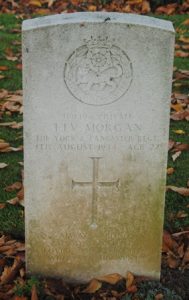
David Thomas Price, Fusilier, 1768793, Royal Welch Fusiliers. David was the son of Richard Lewis Price and Mary Jane Price (nee Davies), of Brynhir, St. Harmon. He served with the 1st Battalion, Royal Welch Fusiliers. The battalion had been in France with the BEF at the outbreak of war, fighting a desperate action to hold the crossings on the La Bassée Canal during the retreat to Dunkirk. The survivors were evacuated from Dunkirk to England, where the battalion was rebuilt before embarking for the Far East, for service in India and Burma against the Japanese with the 2nd Division. David died in Burma on 24 February 1945, aged 36. He is buried in Taukkyan War Cemetery, Myanmar.
John Idris Price, Corporal, 510925, Royal Air Force. John was born in 1911, the son of Richard and Ada Evelyn Price, of Esgairannos, Nantmel. He enlisted into the Royal Air Force several years prior to the war and married Olive Julia Gange whilst based near Salisbury in 1934. Following the outbreak of war John was posted to 53 Squadron, RAF, which was based at RAF Detling, in Kent. The squadron was at the time attached to Fighter Command and was equipped with the Bristol Blenheim. During the afternoon of 13 August 1940, the staff at Detling were going about their daily business when the airfield came under attack by German Stuka dive-bombers. The airfield sustained several direct hits, and around 100 RAF and civilian personnel were killed or wounded. John was among the dead. He was 29 years old and was buried alongside many of the casualties of the attack in Maidstone Cemetery, Kent. The inscription at the base of his headstone reads: ‘HIS IS A CROWN OF GLORY. ALWAYS IN OUR THOUGHTS. HIS LOVING WIFE AND CHILDREN’.
Sidney George Pugh, Private, 14664595, Royal Welch Fusiliers. Sidney was the son of William Henry and Kate Pugh, of Nantmel. He enlisted into the army and was posted to the 2nd Battalion, Royal Welch Fusiliers. The battalion was part of 29th Independent Infantry Brigade and in 1942 fought in the Battle of Madagascar. The Brigade was then transferred to Burma, becoming attached to the 36th Infantry Division, and fought in Burma from August 1944 as part of the 14th Army, under General Slim. The Division then took part in the advance to Mandalay and saw action during several fierce battles, especially in the Arakan from 1 January – 12 June 1944. From 12 February 1945 the Division was fighting around Mandalay, and it was here, on 2 March 1945, that Sidney was killed. He was 23 years old and is buried in Taukkyan War Cemetery, Myanmar.
David Ramsay Sladen, Second Lieutenant, 77698, Rifle Brigade. David was the son of Brigadier-General David Ramsay Sladen, CMG, DSO, and Isabel Sladen (nee Blakiston-Houston) of Rhydoldog, Rhayader. He was commissioned into the Rifle Brigade on 25 August 1938, and following the outbreak of war was posted to France with the 1st Battalion, Rifle Brigade, as part of the BEF. Following the German invasion of Belgium and Northern France, the Blitzkreig, the BEF was driven back towards the Channel ports. David was the Commanding Officer of 13 Platoon, ‘I’ Company, and the battalion was allotted the task of defending Calais, while other units were being evacuated from the port. David was killed in action whilst beating off repeated German attacks on the outer defensive line around the town on 26 May 1940. The 21-year-old was originally thought to have been taken prisoner by the Germans and was posted as missing, but he was later found to have been killed on that date. He is buried in Calais Southern Cemetery, France. David was posthumously Mentioned in Despatches for gallant and distinguished services in the Defence of Calais.
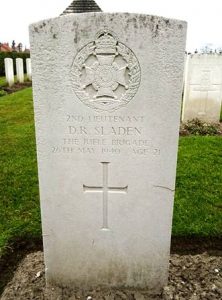
Evan Llewellyn Stephens, Private, QX7852, Australian Infantry. Evan was born on 14 May 1905, the son of John William Stephens and Emmeline Mary Stephens, of Rhayader. He emigrated to Australia prior to the war, embarking at London on 12 April 1935. He enlisted into the 2/26 Battalion, Australian Infantry following the outbreak of war. The battalion formed in November 1940, drawing from men from Queensland and northern New South Wales, and on 24 February 1941 moved to Bathurst, joining two other battalions to form the 27th Brigade of the 8th Australian Division. On 29 July 1941 the Division sailed from Melbourne for Singapore and after arriving camped in Changi. At the beginning of October the battalion deployed to Malaya, and was ready for action when the Japanese invaded and, joining Westforce, fought alongside British and Indian troops against the initial Japanese attacks, conducting a fighting withdrawal to Yong Peng, Ayer Hitam, and a number of other locations, as Westforce withdrew towards Singapore Island. Between 26 and 27 January the 2/26th held the Simpang Rengam crossroads at 46-mile post, where they were shelled by Japanese artillery and strafed by Japanese aircraft. By 28 January the 2/29th was involved in the heavy fighting at the Namazie Estate rubber plantation. That day and the next the battalion inflicted heavy casualties on the Japanese, but was forced to surrender when the British commander of Singapore surrendered on 15 February 1942. Evan was taken to Changi Jail with the survivors of his battalion, who were then used as slave labour, with many sent to work on the Thai-Burma railway. Evan was among a number of men taken to Malaya POW Camp. As was sadly often the case, his health deteriorated badly whilst in captivity and Evan died there of cholera on 26 June 1943, aged 38. He is buried in Kanchanaburi War Cemetery, Thailand.
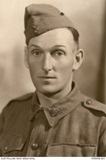
David Ivor Williams, Lance Corporal, 7683759, Corps of Military Police. David was born at Talybont, Cardiganshire on 1 September 1909, the son of Emma Jane Williams, and was educated at Llancynfelyn School. He married Violet Prudence Hanney in London in 1934, and the couple moved to Somerset House, East Street, Rhayader. David enlisted into the army and served with the 18th Divisional Provost Company, Military Police, which was attached to Malaya Command at Singapore. After the Japanese invasion of Singapore on 8 February 1942, the British surrendered a week later, on 15 February 1942, and 80,000 troops became prisoners of war. David was amongst the men captured there. He was one of the men taken to act as forced labour on the Thai Burma railway, and died in Burma, reportedly of colitis, on 20 July 1943, aged 34. David was originally buried near Rangoon, but after the war his grave was exhumed, and he was re-interred in Thanbyuzayat War Cemetery, Myanmar.
